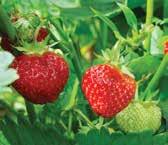


















 Barry O’Neil : HortNZ president
Barry O’Neil : HortNZ president
Just when we think the ground is starting to dry up, another deluge of rain sweeps across the country, causing water pooling as our soils are fully waterlogged. This situation seems to go on and on!
We have just had our wettest winter on record – July 2023 was the wettest since records began in 1863. Multiple extreme rainfall events have resulted in severe flooding and slips across New Zealand.

Winter 2022 has seen low pressure system after low pressure system –to the point where pressure readings have been well below historical averages across every part of the country. Nelson for example, got
one metre of rain over four days, and more than five times its typical August rainfall. This scenario has been repeated in many other regions including Northland, Bay of Plenty, Horowhenua and Canterbury.
And New Zealand has just had its warmest winter on record! The country now has had three consecutive record warm winters. Of the ten warmest winters since record keeping began, six have occurred since 2013.
We know 2021 was our hottest year on record. Last winter our coastal seas were also warmer than they have ever been, with persistent marine heatwave conditions.
And last but not least, we experienced a record cold weather event at the start of October, which brought snow down to sea level, record frosts and low
temperatures. Even areas not prone to spring frosts got hit. While it’s not the first spring frost, it was far more widespread, and while with climate change frosts may not be any more frequent in coming years, when they do occur, they will be more severe.
During these extreme events, we are hearing the use of new terminologies such as atmospheric rivers, microbursts, and thunder snow, which are all unfortunately rather alarming.
The one-in-one-hundred-year weather events that we have been dealing with historically are now more likely to be one in ten years. While previously we might have been able to shrug this experience off as bad luck, only once in one’s life time, this is no longer the case with climate change. At the Horticulture Industry Forum in September in Nelson, we had a great
line-up of speakers. Dr Dave Bellamy from Plant & Food Research gave a really good talk on what climate change will mean for New Zealand. What he said surprised me until I thought more about it.
horticulture, and most of us want to stay in horticulture.
With the inevitable change in weather patterns that climate change is bringing, some of us will need to adjust how we are growing if we want to stay in horticulture.
A drier summer seems to be a certainty. This means we need more water, and to achieve that, we need irrigation from stored water schemes as it’s getting nigh on impossible to be granted additional water takes from the ground or rivers. It’s such a no brainer that with the multiple rain events we have had over winter, we should be taking water from rivers when they are at high flow rates and storing it, rather than letting it flow out to the sea.
Editors: Emily Pope Ph: 027 617 6200
Email: emily.pope@hortnz.co.nz Andrew Bristol Ph: 021 021 62 021
Email: andrew.bristol@hortnz.co.nz
Advertising Manager: Debbie Pascoe Ph: 027 485 8562
Email: debbie.pascoe@hortnz.co.nz
Design: Scenario Communications Ph: 04 385 9766 Email: joy@scenario.co.nz
Subscriptions: Email: info@hortnz.co.nz
We are a very narrow island surrounded by oceans. They are going to have a major effect on our climate, unlike the countries that have a huge land mass, which will affect their climate in different ways.
With us, the oceans will keep our country cooler than others. While temperature will increase due to climate change, our increase will probably be no more than 1.5 degrees, compared to countries with a huge land mass, which are likely to see far greater temperature increases.
The oceans will give us rain, lots of rain, just like we have experienced this winter. And it’s going to be rain that comes in buckets, not showers, which we will have to learn to live with and manage.
And on top of that, La Niña is likely to be with us again for the third year in a row, which in 2023 will exacerbate some regions getting hotter and drier over summer, and also continuation of a wet winter.
As a mate said to me after the frost event, ‘with the risks to growing that these events create, who would want to be in horticulture?’ I’m sure many of us are feeling this way, but we are in horticulture, we like being in
A wetter winter means we need very good drainage systems, but also some low-lying areas may just not be suitable for growing in these conditions unless we modify them such as with covered cropping options.
NZGrower is produced by Horticulture New Zealand and is free for all levy payers. The magazine is also supported by: Vegetables New Zealand Inc, Process Vegetables NZ, TomatoesNZ, Potatoes New Zealand Inc, Onions New Zealand Inc.
The individual comments and views in this magazine do not necessarily represent the view of Horticulture New Zealand.
ISSN: 2230-2700 (Print) ISSN: 2744-5712 (Online)
And frost events, while hard to predict, will require further investment in frost protection. There are plenty of options available, but none of them perfect. However, they are much better than not having any system at all.
It might be hard finding the capital to do much of this, but not investing is going to lead to more frequent years of significant crop losses in the future, something none of us want to see. Unfortunately for me, the photo in this month’s column is from my orchard the day after the 7 October frost.
This publication uses vegetable based inks and environmentally responsible paper produced from Forest Stewardship Council® (FSC®) certified, Mixed Source pulp from Responsible Sources.
Paper produced using Elemental Chlorine Free (ECF) and manufactured under the strict ISO14001 Environmental Management System.
This magazine is posted in an EcoPure plastic sleeve. EcoPure accelerates the biodegradation of treated plastics in microbe-rich environments. Plastics made with EcoPure are biodegradable in aerobic and anaerobic environments.
La Niña is likely to be with us again for the third year in a row, which in 2023 will exacerbate some regions getting hotter and drier over summer, and also continuation of a wet winter
The one-in-onehundred-year weather events that we have been dealing with historically are now more likely to be one in ten years
Kia kaha

It appears that the world is under immense pressure at the moment. Current weather conditions suggest that climate change is happening possibly faster than was predicted or indeed, faster than we would have liked.
The impact of the Russian invasion of Ukraine is affecting the world in terms of how secure people feel – particularly in the Northern Hemisphere – as well as affecting the global supply chain both in movements and increasing costs.
Closer to home, over the past few weeks our government’s change agenda has become more obvious, particularly for the primary sector. In the environment space, the National Policy Statement for Highly Productive Land was announced as well as the government’s response to the He Waka Eke Noa partnership’s recommendations for reducing agricultural emissions. In the labour space, Fair Pay Agreements are progressing and the Immigration minister announced an increase to the Recognised Seasonal Employer (RSE) scheme cap to 19,000 workers for the 2022–2023 season.
At the same time, the Government is introducing a tripartite agreement between industry, unions and the Government, meanwhile missing Pacific representation much to our industry’s frustration.
A substantive tripartite agreement between our industry, unions and the government is also in place for reviewing the settings of the RSE scheme.
This level of change is unprecedented. That is not to say that change is not needed – and in terms of climate change, the world’s response is looking like it is overdue – but what I think is being forgotten is how long change takes and how complicated it is to work through and implement.
In our industry, the application of technology is rightfully held up as being fundamental to meeting new requirements, in both the areas of the environment and labour. Few growers would argue with this but what is forgotten is how long, expensive and fraught changes in
technology are. Think of how debilitating – at least in the short-term – a major computer upgrade can be on any organisation, big or small, then extrapolate that at least ten times to appreciate the impact of a major technology change on growing.
Recently, a vegetable grower voiced how they felt the biggest advance in the past 20 years was ‘tractors being able to drive in a straight line’. I think this is a good example of how complicated – and therefore, long and expensive –technology advances usually are. This then makes me think that as an industry, we had better get going – and I think that’s what our government thinks.
However, to think that industry is not innovative enough, is a mistake. Again, the ability of today’s tractors to drive in a straight line – to reduce soil compaction and increase yields by making better use of available land – after 20 years is an excellent example of how advances take time. Advances are well underway, if only because they have to be, and our growers have understood this for decades.
It often feels like the government thinks that delivering more value – as opposed to growing more of a commodity product – is a new thing. It’s not and here’s why: it takes at least five years and up to ten years to bring innovation into the vegetable space and to the New Zealand market, let alone start to enjoy a return on investment.
Innovation and change is alive and well in the horticulture sector – indeed, the whole industry has been founded on innovation and change, and continues to adapt in order to develop and maintain international and domestic market share
The message I have here for the government is that innovation and change is alive and well in the horticulture sector – indeed, the whole industry has been founded on innovation and change, and continues to adapt in order to develop and maintain international and domestic market share.
The outcome of such high levels of innovation and attention to changing requirements is a horticulture sector that is the envy of the world – as well as a sector that delivers for New Zealand, economically and socially.
My message to the government on change and new requirements is this: please be careful to understand all the change that is underway, what it is already achieving, how long it has taken and how expensive it has been –before you implement requirements that seek more change from our sector.
In some areas of New Zealand, vegetables have been grown on the same land by the same families for more than 70 years. These growers know what they are doing. They may not have always used the word sustainable but their track record shows they have always known what this word means and its importance for the longevity of their businesses.
What our growers need is a policy and regulatory environment that enables them to do what they are capable of doing and have been doing for years. Change in order to adapt to changes in growing conditions, consumer preferences and social licence norms, to increase or maintain market share – and in order to be able to keep doing what they do best and most enjoy – growing healthy, great tasting food for New Zealanders and the world.
Across industries and applications, we design specialised solutions.
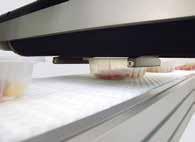

Bringing together leading brands in weighing and packaging equipment for the food industry. Our solutions set the standard for yield, efficiency, and safety across a wide range of industries. Whatever your product needs, we can meet it with precision and passion.

info@heatandcontrol.com

In some areas of New Zealand, vegetables have been grown on the same land by the same families for more than 70 years

The Ministry for the Environment (MfE) is drafting new regulations that will set a national direction for Freshwater Farm Plans across the country. These regulations will capture orchards/farms with five or more hectares of horticultural land use, and those with 20 or more hectares of arable/pastoral/mixed land uses. Freshwater Farm Plans will capture all owned and leased land blocks.
The planned rollout of the regulations begins in 2023 with three regions – the Waikato, Gisborne and Southland. MfE is looking to undertake pilots in these regions before the end of the year.
You can also visit our website to read more and register for a Freshwater Farm Plan webinar in November or December.
Tūtaekurī, Ahuriri, Ngaruroro, Karamū Catchment (TANK)
The Independent Hearing Panel has made its decision on Proposed Plan Change 9: Regional Resource Management Plan – Tūtaekurī, Ahuriri, Ngaruroro, Karamū Catchment. The decision was notified on 9 September 2022. There are many aspects of the TANK decision that HortNZ supports, however, we have made a targeted appeal to seek clarity for growers.
HortNZ and Good Agricultural Practice (GAP) are engaging with MfE to get it to recognise industry assurance programmes like GAP to deliver Freshwater Farm Plans. We are working with growers and councils to run parallel pilots using GAP to deliver on regulated freshwater outcomes. If you grow in the Waikato, Gisborne or Southland, and you have been contacted by your council to participate in a Freshwater Farm Plan pilot, please contact HortNZ and we can support you.
The key aspects of the HortNZ appeal are to ensure that: the location and extent of source protection zones/extents take into account the location of highly productive land the land use change framework is clear, consistent and workable they allow for rootstock survival water to be taken as a permitted activity during times of low flow the plans facilitate the operation of stream flow maintenance and habitat enhancement schemes.
INDUSTRY WIDE ISSUES FOR INDUSTRY GOODThe Ministry for the Environment (MfE) is drafting new regulations that will set a national direction for Freshwater Farm Plans across the country

HortNZ has a submitted on this plan change. We support the focus on residual risk associated with the location of facilities that use, store and dispose of hazardous substances. We also sought minor amendments to define and manage residuals risks.
HortNZ submitted on the Far North District Plan. We sought the following outcomes:
• Definitions and rules that recognise the importance of primary production
∙ Reverse sensitivity Ancillary earthworks Seasonal accommodation Greenhouse
Artificial crop protection and crop protection structures.
• Provisions that recognise highly productive land in line with the National Policy Statement for Highly Productive Land
• Strategic direction that provides for primary production and which is not compromised by other activities
• Requirement for councils to undertake indigenous biodiversity mapping and not landowners
• Less restrictive operating rules for audible bird scarer devices and frost fans
• Provisions for activities and buildings/structures that are an inherent part of horticulture
• Appropriate setbacks for dwellings, buildings and artificial crop protection structures from boundaries.
HortNZ also submitted on this plan change and sought the following outcomes.
HortNZ and New Zealand Kiwifruit Growers Incorporated (NZKGI) opposes proposed Plan Change 6 (PC6) in its entirety and seek withdrawal of proposed PC6.

HortNZ and NZKGI accepts the need for provisions in the district plan regarding noise levels to ensure they
are appropriate for the rural operating environment and that compliance with such noise limits can be enforced. We also recognise that there needs to be a balance between providing for horticulture activities and resident amenities. It is HortNZ and NZKGI’s contention that PC6 is inappropriately balanced towards residents and will have a negative impact on horticulture production in Whakatane. Of specific concern to HortNZ and NZKGI is the monitoring undertaken by the council detailed in the Section 32 Report. It has not been robustly confirmed that the issue in Whakatane relates to audible bird scaring devices that comply with the operative limits or whether the issue relates to non-compliance.

The desire for a change in pace and the allure of an untapped New Zealand food market led Brian Turley to give up his 25-year career as a chef in favour of growing one of nature’s superfoods – mushrooms. Eighteen months on and Brian has no regrets. ELAINE FISHER reports.
Aniseed, vanilla, orange and cinnamon are not aromas commonly associated with mushrooms but for Brian Turley of Motueka, they are among the engaging attributes of the fungi.
“Most people don’t notice the smell of mushroom mycelium, but those of us who grow them do and can identify different fungi by their smell,” says Brian, who grows and sells fresh mushrooms and mushroom products at local markets under the name Mighty Mushrooms. Mycelium is the network of threads, called hyphae, from which mushrooms grow.
“Many fungi have a sweet, pleasant smell. Phoenix oyster mushroom mycelium smells of aniseed and vanilla, and Hericium novae-zealandiae – or coral tooth – which is native to New Zealand, smells of cinnamon and oranges.”
It was, however, the taste, texture, appearance and relative rarity of gourmet mushrooms which prompted the former chef to grow them himself.
“When I was working in London, we had access to a very wide variety of mushrooms but when I returned home to Auckland, I found it hard to source the more unusual varieties.”
After 25 years of working as a chef in both New Zealand and overseas, Brian and his wife Chomphoo decided to seek out a quieter, more family friendly lifestyle in the Tasman region. That was 12 years ago and while Brian initially continued to cook, the physical toll the work took and its long hours caused him to look for something different.
Two and a half years ago he founded Mighty Mushrooms, learning by trial and error how to cultivate and grow mushrooms commercially and how to process them into a range of gourmet products.
Today he grows mushrooms which are native to New Zealand; the oyster (Pleurotus parsonsiae) or velvet mushroom; shiitake (Lentinula novae-zelandiae); coral
tooth (Hericium coralloides now known as Hericium novaezealandiae) or Pekepeke-kiore in Te Reo. He also grows enoki (Flammulina velutipes) – including the enokitake variety known as velvet shank.
The gourmet varieties were chosen because few other growers were producing them and they grow on sterilised wood pulp rather than compost, meaning they are ideal to grow in an urban environment.
Growing and processing mushrooms is now a full-time job for Brian. The process begins with cloning each variety to produce the next generation.

“We use cloning so we can be sure of the quality of the mushrooms we grow,” he says.
Small tissue samples are grown on agar in a petri dish, or in a sterilised honey and water solution. The resulting substance from these processes is called spawn, which is injected or placed into bags of sterilised organic rye or oats. Once sealed, the spawn is left to multiply inside the bags which sit on shelves in a dark room.
“The ideal temperature is around 20 degrees for this step,” says Brian, lifting a bag of what looks like mouldy grain from a shelf.
Once the fungi have spread through the grain or oats it is added to the growing medium made from shredded wood pellets.
“I used to use oak and macrocarpa mulch, but now I buy bags of pine pellets used for solid fuel domestic fires,” Brian says. “The process of turning pine into pellets removes all the oils which fungi don’t like and the product is virtually sterile.”
Shiitake mushrooms won’t grow on pine mulch, so Brian uses pellets which are sold for smoking fish.
He further sterilises the wood before introducing the fungi, and the bags are then moved to one of four growing rooms which are also temperature controlled. There the fungi are kept moist by misting devices which encourage growth. As the mushrooms mature, they protrude out of the bags, ready for harvesting.
During the peak of the season Mighty Mushrooms produces up to 50 kilograms of mushrooms.


“We sell only our best mushrooms at the markets, using the rest to make our products, so nothing is wasted,” Brian says.
Those products include pickled mushrooms, Thai mushroom soup and mushroom curry.
“We probably sell more of our mushroom products than fresh mushrooms.
“We sell most of our mushrooms direct to the public at markets, but also supply some top-end restaurants.”
Brian attends the Nelson Farmers’ Market on Wednesdays, the Nelson Market on Saturday and the Motueka Sunday market.
Since he began growing mushrooms commercially, Brian has been continually learning about the fungi. There are more than 2000 species of edible mushrooms grown all around the world and many which can cause death.
Thankfully, Brian says that of New Zealand’s native mushroom varieties, very few are deadly.
“Fungi are neither plant nor animal but belong to a kingdom of their own,” Brian says. “We are more closely related to fungi than to plants, which is why mushrooms can have such a huge impact on our bodies.

“The Chinese have been using mushrooms as medicine for thousands of years, but western science is only now finding out about their benefits.”

The gourmet varieties were chosen because few other growers were producing them and they grow on sterilised wood pulp rather than compost, meaning they are ideal to grow in an urban environmentFresh enoki mushrooms Taweka, also known as poplar mushroom (Cyclocybe parasitica), is a native New Zealand species with a savoury flavour and firm, meaty texture When young, coral tooth mushrooms are soft and edible. As they age, the branches and hanging spines become brittle












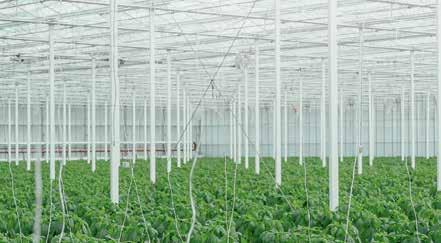
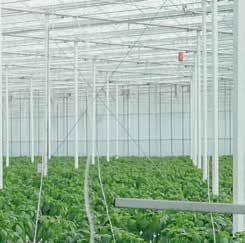



A study is underway in the Tasman region to quantify the amount of nitrogen captured from green crops and calculate the profitability for growers. The Rural Professionals Fund is funding the nine-month study which is one of 12 projects nationwide to test innovative ideas.
Market gardener and former scientist, Dom Ferretti, has teamed up with Sustainable Nutrition consultant, Sjef Lamers, to carry out the trial on a Brightwater property. It will look at the effect of green crops such as tic beans, peas, broad beans and lupins on a crop of potatoes.
Overseas data shows green crops alternated with largescale arable crops can capture considerable nitrogen, but there is currently no New Zealand data. Dom says the time is right for work to be carried out for market gardening due to the increasing cost of fertiliser, environmental rules and regulations, and more rain events.
“If we can prove this is economic, we can get people over the line to try it,” Dom says.
By taking soil samples and plant biomass samples, they will be able to work out how many kilograms of nitrogen per hectare is produced by green crops.
The green crops capture nitrogen out of the atmosphere and draw it down into the soil, which is known as nitrogen fixation. Pastoral farming uses plants such as clover for nitrogen fixation – something Dom says vegetable growers could use more as well.

Alongside the project, a series of measurements will be captured to indicate what is happening to that nitrogen, whether it remains in the soil profile or leaches into the ground water. While those measurements will be outside the scope of the funding and timeframe of the project, Dom says gathering that information will identify whether there is potential for further research.
The project will use potatoes because it is easier to measure yield, comparing a control crop with crops of potatoes grown alternately with two types of green crops. The theory is that the green crops will produce a higheryielding crop of potatoes.
Dom uses green crops regularly in his small
market garden and says they do not interrupt his crop rotation.
“It’s all about planning a crop rotation and there’s always downtime when there are weeds growing, so we want to operate within that band,” he says. “You don’t do the whole farm at once and you don’t miss any planting dates due to it.”
He says most vegetable growers have large enough operations to trial areas of green crops and see the results.
Growers will need to buy seed – which is grown in New Zealand and is available at a reasonable cost – and use a tractor to sow the seed, but if those crops provide renewable nitrogen to the soil, then it could be financially worthwhile for growers to include green crops.
As fertiliser costs escalate, green crops could provide a viable alternative to capture and supply nitrogen for vegetable production.organic
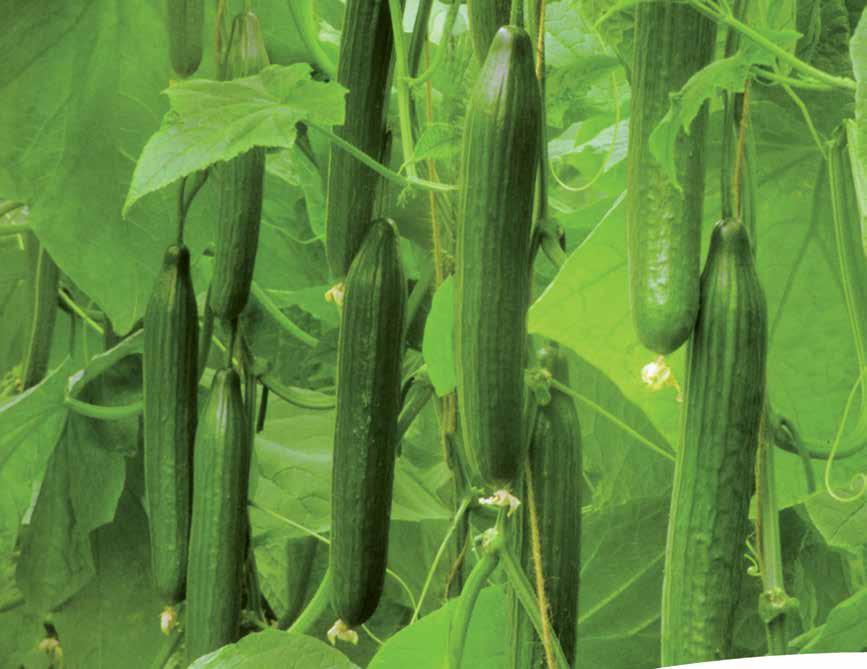
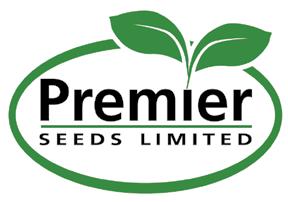

The director of Masters Produce passed away on 11 September surrounded by his family and loved ones at the age of 71.
The third child in a family of eight siblings, Pravin attended boarding school in Surat in western India for four years before moving to New Zealand, where he attended Bombay Primary School in South Auckland, and then Pukekohe High School. Pravin’s involvement in the horticulture industry began at the family market gardening business, established in the 1950s and originally named H Master and Sons, where he helped his older brother and father.
Twenty years on and with the business expanding, Pravin
took up an active management role in the day-to-day operations of the family greengrocer and market gardens business. At its peak, Masters Produce Market was one of the largest, and arguably most successful, independent roadside store in New Zealand. Despite closing its Bombay crossroads store in 1996, the operation continues to grow a variety of high quality potatoes, onions, lettuces and cover crops for fresh and processed markets both domestic and overseas.
Pravin is remembered by fellow growers as having an incredible drive and passion for business, be it farming, business negotiations and deals or fresh produce retailing –

Pravin Master of Bombay has been remembered as a vegetable grower and retailer who shaped the way produce is now traded and sold in New Zealand.
I don’t liken people to potato varieties very often, but if Pravin was a potato, he would be an Ilam Hardy
which came naturally to him as he excelled at connecting with people.
He also loved providing for others, being a proud supporter, volunteer and trustee on the Pukekohe Indian Association (PIA) board, as well as being a generous benefactor of other local community groups.
General manager of Unearthed Produce, Ben Buchanan, gave the eulogy at Pravin’s funeral service held at the PIA hall in Pukekohe. He says produce and Pravin’s life were intertwined.

“Even in his final few days he still showed a keen interest in what was happening in the market and how this year had turned into a bookmarker year of how things have played out differently,” Ben says. “People and relationships were very important to him and he had a philosophy of keeping things simple and doing something the right way rather than the easy way.
“I believe his fingerprints are on the way that we now trade and sell produce in New Zealand.”
Pravin was instrumental in setting up Unearthed Produce, which was formed in 2021, to strengthen and grow the root vegetable industry, providing customers with fresh, quality produce delivered through a streamlined, efficient end-toend service.
Having worked alongside Pravin for the past 11 years, Ben says he noticed Pravin’s considered approach, whether it was in a growing capacity or as a greengrocer.
“Whether it would be how to plant a Rua [potato] to give it the best chance to yield well, or how to sell a truck and trailer of stonefruit from John Paynter back in his retailing days, he [Pravin] always had a plan and he always kept it simple,” Ben says.
When Masters Produce Market was operating, Pravin drove home the message that in order to sell something, the retailer needed to be able to sell the back story of the product. That was a very different approach to what was happening in the market at that time.
“To Pravin’s credit he thought there was a better way of linking supply with customers, and he went about ensuring that he could demonstrate how this could work,” Ben says.
“This very much sums up a man who knew what he wanted and went about ensuring it would be successful. Again, [it] demonstrates how much he was ahead of the curve in the produce industry at that time.”
Pravin’s work over the years culminated in Unearthed Produce coming to fruition. Ben says he is proud to have played his part in something for which Pravin had laid the foundations.
“I don’t liken people to potato varieties very often, but if Pravin was a potato, he would be an Ilam Hardy,” says Ben. “Ilam [variety] continues to have a place in the market because nothing else has come along to supersede what they can deliver.”
This sums up Pravin’s impact on the produce sector with his simple but effective approach being profound and long-lasting.
Pravin is survived by his wife Ramaben, three children and three grandchildren.
Pravin is remembered by fellow growers as having an incredible drive and passion for business, be it farming, business negotiations and deals or fresh produce retailing – which came naturally to him as he excelled at connecting with people
Vegetables are getting a big boost thanks to Vince, a plant-based dehydrated mince produced in Whangarei, which will be in New World stores soon and has already been included in My Food Bag.


Then there’s the export opportunities, with a pallet of the product receiving consumer acclaim in Japan and there being interest from United Kingdom supermarket chains, Tesco and Sainsbury’s.
The development of Vince started when café owners, Debbie and Nigel Stowe, changed to a plantbased diet after their daughter suffered a range of debilitating health conditions, including eczema and crippling stomach pains.
After two and a half years of no improvement, the family went dairy and gluten-free.
“Then we were on holiday over Christmas and ate only fish and vegetables,” Nigel says.
“Within three or four days, our daughter was sleeping through the night, so we knew something was working.”
The family made the decision to remove red meat from their diet but there were things that they missed, like mince, which could easily make up the base for lasagna or tacos. Debbie looked for plant-based alternatives but found the few that were available were highly processed.
Debbie started experimenting with what she was cooking in their café, using quinoa as a base for a plant-based nachos dish.
“People didn’t realise they weren’t eating meat,” she says. That led to her completely overhauling the café’s menu, adding 10 to 12 new vegetarian items.
In 2016, they sold their café and set up Olive and Ash, named after their children, Olivia and Ashley. The plan was to market an activated granola – which had been popular at the café – but that costed out at around $20 a packet.
“It was a little too niche and we wanted a scalable business,” Debbie says. “We also didn’t want to deal with a refrigerated supply chain.”
Taste was paramount. The couple found that dehydrating the vegetable mix they were using – which incorporates tomatoes, peanuts, cauliflower, carrots and celery –intensified the flavours, as well as ensuring the product lasted for more than 12 months.
They have found that for customers one of the most common uses of Vince is to mix it with mince, although some use mushrooms or beans.
“Everyone can be happy at the same time,” Debbie says. “Sometimes people don’t tell their partners or kids.”
While Olive and Ash is now based out of a fitted out shipping container, they hope to move to larger premises in the new year, after raising some capital. They have applied to the Regional Strategic Partnership Fund, which they hope will keep the business based in Northland and mean an increase in staff from the present two to double or treble that number.
In the new year, the business will start sourcing its vegetables from Bells Produce in Kaitaia. They have already moved away from using Italian canned crushed tomatoes to support local product, and may look to dehydrate vegetables in season when they are plentiful.


In the future, they would like to look at burger patties, sausages and curries, all made from vegetables.

“THERE’S REALLY NO VALUE-ADD PROCESS FOR NEW ZEALAND VEGETABLE GROWERS,” NIGEL SAYS.
“WE’VE SORT OF STUMBLED ONTO WANTING VEGETABLES TO BE THE STAR OF THE PRODUCT.”
Once their fledgling watermelon plants reach the field, Gordon McPhail (right) and Andrew Rosso use a plastic mulch to both suppress weeds and increase heat units
Loved by consumers, but tricky to grow, LeaderBrand is busy investing in a domestic watermelon crop to produce a delicious, sustained supply for the local market. KRISTINE WALSH speaks to LeaderBrand’s Gisborne team on the company’s renewed interest in the crop and the challenges and opportunities it brings.
There was a time when LeaderBrand general manager of farming, Gordon McPhail, took care of growing the company’s watermelons himself – a task he says was all but easy.
“Watermelons can be a very fickle crop and if things go wrong, you can lose an entire paddock overnight,” Gordon says. “That’s why our cropping manager, Andrew Rosso, takes care of that now. It’s a matter of playing to your strengths.”
Watermelons aren’t a new crop for Leaderbrand’s Gisborne team. The company grew them until 2019 when the decision was made to stop growing them while they

focused on developing other branches of the business and supporting infrastructure, such as LeaderBrand’s new distribution centre in Gisborne city and a major covered cropping facility just out of town.
“The watermelons do need a lot of care, attention and investment, so at the time, we decided to devote our resources to our expanding salad business, as we saw getting this right first, as being crucial,” Gordon says. “But with the business on track and a renewed focus on our value-added products, we decided the 2021–2022 season was the right time to get back into supplying [watermelons to] our domestic market.”
Gisborne’s long sunshine hours, high number of heat units and fluctuations between day and night temperatures really brings sugar levels up. Gordon says this makes Gisborne one of the best regions in the country to grow watermelons.
But the product is not without its challenges, a big one being the prevalence of the fungus Fusarium, a destructive problem for growers around the world.
“The issue for us is that the Fusarium that affects watermelons is the same [fungus] that affects squash,” Gordon says. “Both [watermelons and squash are] from the cucurbit family. With squash being a large part of our business for many years, our soil has a high risk of infection.
“With that increased risk of disease we had to make sure we kept on top our our research and did the work at nursery and ground prep [sic] stage to minimise any potential for that.”
Even though LeaderBrand has a history of growing watermelon, it put testing and development at the centre of its market re-entry.



“Our aim is not only to grow the best produce, but to work hard to ensure consistency of supply,” Gordon says. “So, while we did supply the market last season, our main focus was on research and experimentation to ensure we could get a good supply of great product for a sustained period of time.”
The team invested in a great deal of background research, including travelling the world to learn grafting and growing techniques that could be developed into their own pioneering methods, while avoiding disease.
“We did that before 2019 and the investment and management required was one of the reasons why we put watermelons aside for a couple of years while we focused on areas like the salad side of the business,” Gordon says. “We wanted to make sure we could give the melons the attention needed to grow them really well, but made it clear to our customers that we weren’t out for good… just taking a break.”
A renewed focus on the domestic market has helped LeaderBrand hone its approach.
“While we are looking at producing 3000 tonnes a season now, our aim is to grow the market and grow the volume to meet it sustainably,” Gordon says. “But we have to earn the right to do that by growing good varieties and handling them well so consumers get the best possible eating experience, and by offering our customers – the supermarkets – consistency of supply.”
Like other Gisborne growers, LeaderBrand had a tough 2021–2022 season. Watermelons are generally planted by the first week of October and in November the region was hit by catastrophic rain.
“There were challenges around timing, but we still managed to reintroduce ourselves to the market with good volumes and great quality product, while carrying out the experimentation needed to take us into the next season,” Gordon says. “Even though more rain has made for late planting this year, the trials we did the previous season have given us great confidence in our growing programme going into summer of 2022–2023.”
Four varieties of watermelon will be produced in this year’s summer programme – a couple of the large, striped Jubilee-style melons; and a couple of smaller hybrid “micro seeded” varieties, known for their small seeds and dense flesh.

“The reality is that while many buyers love the huge, eight-kilogram melons, others prefer something a bit more manageable,” Gordon says. “This way we get to cater to both sides of the market to ensure everyone has a great experience.”
Once harvested through January and February, all will be treated like green gold, with LeaderBrand well set up to handle them at its post-harvest facility that is also used for squash.
In New Zealand, watermelons are planted between October and mid-November to produce from January to March.
Gordon says gentle handling is key. The melons are handpicked when ripe and placed – again by hand – onto a belt to be brushed, washed, dried, graded and packed, all floated through water to ensure they emerge undamaged.
“We value our brand so it’s part of offering reassurance to the customer that when they pick up a LeaderBrand melon, it’s going to be the best they can get,” says Gordon. “It also builds a real sense of ownership for our team when they know they are putting out the best quality product.”
Achieving the best quality comes down to spending time investing in trials, selecting the right varieties, planting in the right soils and conditions, and treating the melons right post-harvest, Gordon says.
“For us, they’re an exciting product where there is huge potential to develop new varieties, while the category is one that fits really well with our business and supply model. “And at the end of the day, who doesn’t love a good watermelon?”
A member of the Cucurbit family – cucumbers, pumpkins, squash, zucchini, marrow and more – watermelon is considered a vegetable.
In ideal conditions watermelon plants can produce up to 70 tonnes per hectare if given an extended period of warm weather to produce well.
New Zealand has about 20 watermelon growers, though smaller operators are dotted around the country.



Boyds Asparagus managing director Andrew Keaney had hard and fast decisions to make on an early October morning following an unusual polar blast that brought snow and frosts well up the North Island.
Pictures show one of Boyds’ key fields covered in the grainy texture of ice with the early season harvest lying ruined somewhere beneath.
The decision came down to cost: mow in 164ha or get the picking teams to work their way through the remains, harvesting salvageable new spears, while clearing the wilting wreckage off the top.
Andrew chose the mower. Bringing in workers to tidy up and do in two or three days what would normally take a day would have cost even more.
The frost hit was a set-back for those dependent on what they could sell in the domestic market. For Boyds it was around 60 tonnes of product, equivalent to 200,000
bundles, and a revenue loss of about $300,000.
“The biggest concern to me is the significant loss of revenue in a marginal business. These days our market is really the North Island, but after Labour weekend the prices drop below the cost of production.“
The frost cost ten days of production at a time of year when prices were at their best. Boyds’ usually bustling packhouse lay deserted. But it was not the end. New spears would come away. One hundred and eighty seasonal workers, many from the local community, had to be scheduled, with some paid for a portion of the usual time – to prevent them from going elsewhere and adding to the overall labour problems.
The impact on the availability of asparagus to the market would be minimal, as growers in the Hawke’s Bay and Horowhenua would make up the difference, Andrew says.
This isn’t the first time Boyds had been hit with frost in 2022. Another cool night brought frost in early September, but luckily only on a 20ha block with a loss of about two to three tonnes.

“We’ve had frosts before, but never as widespread. We have six blocks within a 40km radius and this is the first time frost has hit them all.“
According to Andrew, there wasn’t a lot that could be learned from the experience, or put in place as a protection should the same event happen next year.
For the past 12 years, Greenfern has grown white asparagus. Sweeter and juicier, white is a favourite in up-market restaurants
“Unfortunately for us, there’s not a lot we can do. It would cost $100,000 to get a helicopter in. The margins are just not there.“

Only ten minutes’ drive away from Boyds is Greenfern (Les Asperges Ltd), where Bill Cummings and his son Hadyn grow asparagus. They were also hit by the frost, but have more strings to their bow.

The bulk of Greenfern’s asparagus crop is the green variety, providing about 35 tonnes annually, with small quantities in purple. About half goes out to organic wholesalers and the rest through the Farmers’ Markets.
For the past 12 years, Greenfern has grown white asparagus. Sweeter and juicier, white is a favourite in up-market restaurants. Blacked-out and insulated tunnel houses allow white asparagus to be grown in warmth and total darkness. These now cover about one-third of a hectare, and produce 20 to 30kgs a day.
Bill Cummings is 73. His son Hadyn works in the day-to-day management of the family business, having moved in the past couple of years from working for salad greens grower Southern Fresh Group – right next door on Bruntwood Road.
Along with asparagus, Greenfern also grows globe artichokes, gourmet carrots and fennel.
Artichoke is a variety of cultivated edible thistle. The edible portion of the plant consists of the flower buds before the flowers come into bloom. It has a short, two-month season.
“We started growing artichokes about ten years ago and put in 1000 plants. We have since introduced new varieties. Artichokes are very popular with people who know about them, particularly through the Farmers’ Markets.“
Fennel is a perennial herb of the carrot family (Apiaceae) grown for its edible shoots, leaves and seeds. Fennel is cultivated in temperate regions worldwide, and all parts of the plant are aromatic and used in flavouring. The bulb-like
stem base can be eaten as a vegetable.






Greenfern is organic. But Bill says this strategy has not been without its problems with invasive weeds. The Greenfern operation had experienced a very mild winter which had allowed an early crop. Things were looking good for the new season.
“But this plateaued and we got a colder spring and then, just when we thought we were getting ahead, we were hit by the first big frost we’d had in 20 to 30 years.“
The Antarctic blast knocked out 2.5ha of green asparagus, and followed last year’s struggles with Covid-19 lockdowns, which blocked access to the usual asparagus outlets through restaurants.








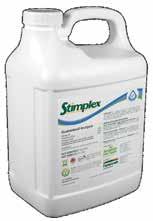
















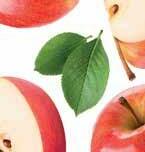

The Ahuwhenua Trophy – Excellence in Māori Farming Awards celebrate excellence in the dairy, sheep and beef, and horticulture sectors on a rotational, three-year basis. The Ahuwhenua Trophy, now entering its 90th year, was first awarded by Tā Āpirana Ngata and Lord Bledisloe in 1933 and has remained hugely prestigious ever since.
The inaugural Ahuwhenua Horticulture Trophy was awarded in 2020, and the 2023 competition will see Māori excellence in horticulture celebrated for the second time.

We had the privilege of speaking with the 2020 Ahuwhenua Horticulture Trophy finalists to find out how the Ahuwhenua competition supported their businesses and communities. With the backdrop of COVID-19 and the uncertainty that lockdowns brought to the well-being of communities, 2020 presented its unique challenges for the competition. The lockdowns not only impacted the hosting of Ahuwhenua ‘field days’, a highly anticipated component of the competition, they also delayed judging. Nonetheless, the competition forged ahead, and the judges were able to visit all three orchards and meet the trustees at each.
We met with Norm Carter, Chairman of Te Kaha 15B Trust, the Trust responsible for Hineora Orchard, for a kōrero. Hineora Orchard is a Māori freehold land block located in Te Kaha in the Te-Whānau-a-Apānui rohe (region) of the Eastern Bay of Plenty. The total block is 11.78 hectares, and its primary operation is 8.13 hectares of SunGold kiwifruit. Te Kaha 15B is one of six Trusts in Te-Whānau-a-Apanui working collectively to enhance and grow their economic assets to give back to owners and their community. This has seen over 20 years of investment in kiwifruit.
There was a large amount of information to be collated for the competition and at times, Norm reports wanting to “give up”. However, the Trust persevered with the competition, which they then went on to win. Upon reflection, Norm believed it “helped them to strengthen their knowledge of their business operations and helped strengthen their overall strategy.” “A highlight was winning the competition and the opportunity for the shareholders and community to come together at the function and celebrate success for Māori in horticulture”, said Norm.

We also met with Homman Tapsell, Trustee of Otama Marere Trust, who was proud of the achievement and recognition of the work achieved by the collective trustees, and proud to tell the story of Otama Marere. Otama Marere orchard is located in Paengaroa in the Bay of Plenty rohe (region). The total land area is 45.01 hectares of predominantly flat land. As well as its kiwifruit operation, lower, wetter parts of the block have also been planted in wetlands. The orchard area is made up of:

• 11.87 hectares of Green kiwifruit
• 2.21 hectares of SunGold kiwifruit
• 7.08 hectares of Organic SunGold kiwifruit
• 2.10 hectares of GEM Avocados
Homman believes the competition is “a good representation for Māori growers, a great way to get whānau involved in the process, and a useful tool for succession planning.” A key takeaway for Homman and his trustees was being able to collectively refine their operation by identifying different parts of the whenua and its rich history. “The Ahuwhenua competition helped us with our whakapapa connection to the orchard”, said Homman.
We also met with Riri Ellis, Chief Executive Officer of Ngai Tukairangi Trust, to hear about their Trust’s experience of participating in the 2020 competition. Ngāi Tukairangi Trust is located on the Matapihi peninsula of Tauranga Moana. The trust has several kiwifruit operations:

• 36.1 hectares SunGold
• 12.70 hectares of Green Kiwifruit
• 6.90 hectares non producing SunGold and a trial kiwifruit variety
• 60.0 hectares SunGold in Hawke’s Bay
Riri said “The competition process was challenging and required time and resources. However, the field day was a great success, and a key highlight of the overall competition was the bringing together of whānau and creating that cultural connection for all who attended. The footage created by the Ahuwhenua committee was great too, and will be kept as a resource for our whānau.”
Maatutaera Akonga from Hawke’s Bay won the inaugural Ahuwhenua Young Māori Grower Award for 2020. Maatutaera is the Senior Leading Hand at Llewellyn Horticulture, and manages 80 hectares of apples.




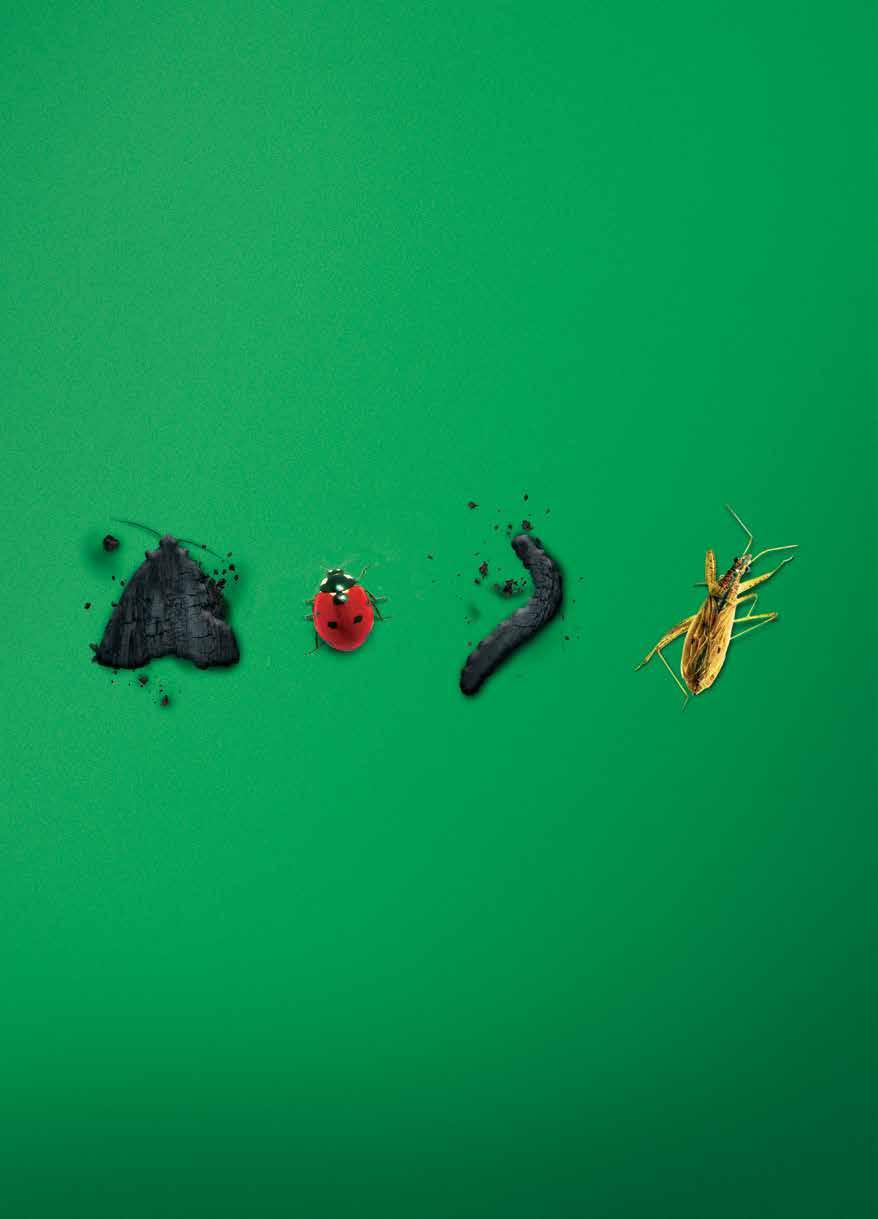
The

Just four months on from the official opening of Countdown’s Auckland Fresh Distribution Centre and the facility is already delivering fresh produce to 152 stores across the North Island. HELENA O’NEILL checks in with supply chain manager, Sean Severin, to find out how the new centre ensures growers’ produce hits consumers’ tables in top-notch condition.
It’s been a busy year for Countdown. In May 2022, Woolworths NZ joined the Woolworths Group Supply Chain and rebranded to become Primary Connect – an end-to-end supply chain partner within Woolworths Group.
It’s one of New Zealand’s largest retail supply chains, supporting businesses within Woolworths NZ (Countdown, SuperValue and FreshChoice). Primary Connect New Zealand manages the transport of freight into Countdown’s distribution centres and any other location around New Zealand.
Officially opened in July, Countdown’s new Auckland Fresh Distribution Centre (AFDC) located in Wiri covers a whopping 20,000 square metres and has state-of-theart systems in place to ensure all produce is delivered promptly and in premium condition.

Primary Connect AFDC supply chain manager, Sean Severin, says the $150 million facility handles between 30,000 to 40,000 cartons a day.
“Some product is held for a day, and that’s as long as we would hold it,” Sean says. “The product comes in via the grower’s delivery, it’s receipted in the morning, we check it and do a quality inspection on it and then we put it away. From there we do our selection process through the night.”
Staff deliver produce to 152 stores across the North Island seven days a week, 363 days year.
“We get our quiet time in the morning when we’re basically just receiving,” Sean says. “When the selection starts up, then all the machines are running, people are picking at pace, we’re consolidating, wrapping, reloading vehicles and dispatching vehicles all throughout the night.”
The new temperature-controlled building is chilled in different zones for optimum storage conditions of different produce types, and centralises Countdown’s fresh product operations.

“We bring in between 50 to 70 loads of products every day from a myriad of different vendors [growers] and transporters,” Sean says. “We have ripening capabilities that have yet to be commissioned but they will be operational by next year. We’re also hard linked “via an air bridge to the Hilton Foods plant next door, [where] we consolidate the meat and produce together in single loads and dispatch that overnight as well. It’s part of optimising the use of our transport network.”
The Wiri location is ideal, Sean says, as the site is close to the main highways meaning ease of distribution, although the bulk of their stores are around Auckland.
Countdown’s sustainability commitments include zero food waste to landfill from stores by 2025, a minimum 5 Green Star rating on all new buildings by 2025 and a 63 percent reduction in emissions by 2030 from a 2015 baseline. Green Star certification is a formal process managed by New Zealand Green Building Council, during which a building, fit out, or precinct is awarded a rating by an independent, third-party assessor.
“This is a 4 Green Star rated site,” Sean says. “It’s the only warehouse that we know of that has been designed to this level.
“We have reusable rainwater for all our greywater and all energy-efficient lighting is on sensors. We utilise solar power and our refrigeration system is at a fraction of what traditional refrigeration in a facility of this nature actually spits out.”
The solar generation at the AFDC alone is expected to offset approximately 183 tonnes of CO2 per year.
The site also has dedicated bays for electric vehicle charging, Sean says.
On the health and safety side of things, the AFDC utilises a global wheel-lock restraint which automatically engages the rear tyre of the truck or trailer with a barrier and it cannot move away until released from inside the dock area.
Designed to stop dock accidents, these wheel locks prevent the dangerous creeping and premature departure of vehicles during the loading and unloading of trucks and trailers.
Sean says the biggest challenge in launching the new centre was getting all staff trained and skilled and the facility operational.
Primary Connect has another facility in the pipeline – a $99 million fresh distribution centre in Rolleston, Canterbury. The 11,000sqm development will service stores across the South Island and mirror the larger Auckland facility

“The vast majority of the team that joined us were fresh… they had to be freshly trained in how to work within a distribution centre,” Sean says. “They had to learn the various systems, processes, the procedures. After the induction period, we trained them for a period of almost two months in three different skills. Some people had never driven a forklift before, so we took them from raw until they were licensed.”
The AFDC replaces the older system of shipping from T&G facilities, he says.

“They would bring the produce in, attempt to do the same quality checks and they wouldn’t be under refrigeration. It would be a very manual process of picking onto pallets, consolidating and moving onto refrigerated or non-refrigerated trucks.
“It’s a cut-down in time, quality inspection, temperature control, a whole lot of good things. It’s in order to improve the quality and the offer to the customer. We’ve often been accused of freezing our product. We don’t freeze the product; it is chilled in these temperature zones. They are very cold, but nothing is frozen here.”
Primary Connect has another facility in the pipeline –a $99 million fresh distribution centre in Rolleston, Canterbury. The 11,000sqm development will service stores across the South Island and mirror the larger Auckland facility.
Earlier this year Countdown’s director of property, Matthew Grainger, said with the new AFDC now open and the Christchurch Fresh Distribution Centre (CFDC) expected to open in 2024, customers right throughout the country will be able to experience first-hand Countdown’s dedication to freshness.
“Our local growers put such an immense amount of care and effort into the produce they supply us with, and we have a responsibility to show that same level of effort and care as it travels from farms and into our customers’ baskets and trolleys.”












Meryn Whitehead is a force to be reckoned with. Having just won the title of 2022 Young Grower of the Year, she already has her sights set on new challenges. ANNE HARDIE speaks to the 28-year-old orchard supervisor about her competition experience and what’s next in her horticulture career.

Meryn left the United Kingdom eight years ago after completing a zoology degree, with a plan to see the world. Her first stop was New Zealand and she has never left.
After a stint in hospitality, she took up a seasonal pruning job and discovered horticulture offered everything she wanted in a career, and tied in quite nicely with the science aspect of her degree. As well as soils and plant physiology,
pests and diseases, there are new varieties, marketing and the logistics of getting product to market.
Apart from a personal career goal of liaising with growers providing fruit to a central packhouse and tripping overseas to bring back new horticulture ideas to New Zealand, Meryn is on a mission to spread the message to other young people about the diverse career paths horticulture has to offer.
This means bringing more people into the industry, but also those already working in the industry need to be shown career pathways rather than doing the same job year after year.
Many view horticulture as a seasonal job and often get stuck with a certain job when they do stay, she says. “My role is varied and I love variety,” says Meryn. “I love being challenged and couldn’t do the same
thing every day. Horticulture is great for that. As soon as you get a little bored the season changes and your task changes.
“But a lot of people do get pigeon-holed, and I think we could do better [at] showing them what they can do.”
Meryn says she has been fortunate working at Vailima Orchard in Tasman. The business works with staff to find out what roles they enjoy and provides them with training. That training is critical to keeping staff happy and in horticulture, yet she thinks it is often lacking across the industry.
After a stint in hospitality, she took up a seasonal pruning job and discovered horticulture offered everything she wanted in a career, and tied in quite nicely with the science aspect of her degree
“Someone who is a supervisor with no training doesn’t know how to look after the team and make sure the team enjoys their work,” says Meryn. “If you [have] thrown
someone into a role without training, you are setting them up to fail. They won’t want to stay because they immediately feel they have failed.
“As long as you have the training, the pressure can be rewarding rather than crushing. And you know how to manage your teams when they are under pressure. For some people, that doesn’t come naturally, but with training they can do that as well as have the expertise.”
Training is just part of the equation though, and she says the industry needs to show workers they are valued if it wants to retain them. How well it achieves that will make or break the industry, she says.
“Valuing your workers helps them respond to challenges better and they’re going to support the business through challenges also.”
She encourages employers to talk with their staff about their job to find out if they are happy in their role and discuss opportunities for them in the business. That way, staff stay happy and add value to the business. Staff do not always ask questions and that may be due to a lack of confidence or simply not knowing what to ask.
She acknowledges she is vocal and is the person continually asking questions, which has helped her find her niche in horticulture and seek out a career path to follow.
Versatile wintergreen type for sowing December to May. Medium-deep drumhead shape. Excellent internal quality and field holding. Harvest early winter to spring, dependent on location. Please ask about Fuyu Midori & Haru for cool season harvest windows.
Winter harvest cauliflower at 125-135 day maturity, dependent on location. Sowing mid January to end of March for July to end of September harvest. Strong plant vigour producing an excellent wrapped and well tucked curd.


New addition to our broccoli range. Medium dome and bead, medium dark green head of good size. Compact plant with minimal stem trimming required. From transplant, maturity 75-85 days for autumn and 110-120 days for spring harvest, dependent on location.

Entering the Young Grower of the Year competition has been a step along her career path, enabling her to interact with other young growers from around the country and as well as a range of experts in the sector.

The competition is a daunting exercise though, even for someone outgoing and vocal like herself. She entered last year and that was a training run for this year, which was still a huge challenge.
“It’s very intimidating – it’s scary speaking in front of 300 people,” Meryn says. “For someone who works in an orchard with trees, that can put people off. But if it’s not challenging and a little scary, it’s not worth it.
“Being asked questions by a panel was what made me the most nervous, but I still enjoyed it. I thought I’d never do something like that – and I’ve done it.
“It made me feel part of horticulture and not just like a worker on an orchard. I’ve learnt so much, met so many people and gained so much confidence.”
Meryn would like to see the competition promoted more in orchards and also outside the industry, so newcomers to the industry know what is on offer and what they can aspire to.
On her to-do list is joining the local Women in Horticulture group and working with a young grower group to share ideas and encourage each other in their careers.
Meryn would like to see more interaction such as field days on orchards to glean knowledge from those with decades of experience in horticulture, and provide more opportunities for young growers to learn and to be involved in wider industry circles.
Promoting the varied range careers on offer is on Meryn’s wish list too. For industry to open its gates and invite school groups and other young people into orchards and market gardens would help inspire new generations to join the sector. It will take some organising between health and safety regulations and busy schedules, but Meryn is determined to make it happen.
“It’s getting young people to have it in their minds that horticulture is a possible career,” she says. “You have to invest now for the future.
“Having that positive interaction from an early age and getting them to see where their fruit and vegetables come from. It would help local support for orchards as well, which is important.”
Meryn wins!
Meryn says New Zealand is fortunate to have a horticulture industry that is continually moving forward while retaining its identity which still reflects family and community, even in larger corporate operations.
orchards
started, and part of
Meryn says. “We can’t lose our identity completely
just move forward. Keeping true to values like family, community, heart, passion and spirit with those family orchards keeps people there.”
“I enjoy it so much, I want to see other people enjoy it too.”
Entering the Young Grower of the Year competition has been a step along her career path, enabling her to interact with other young growers from around the country and as well as a range of experts in the sector
“The family
are where we
our identity,”
to
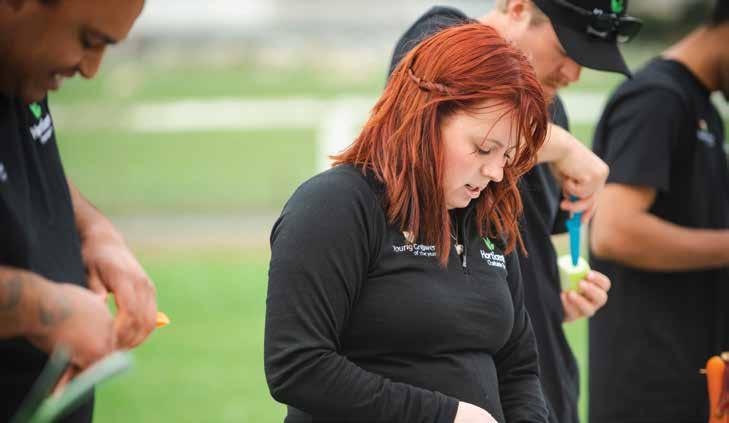

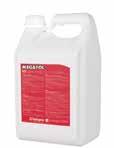
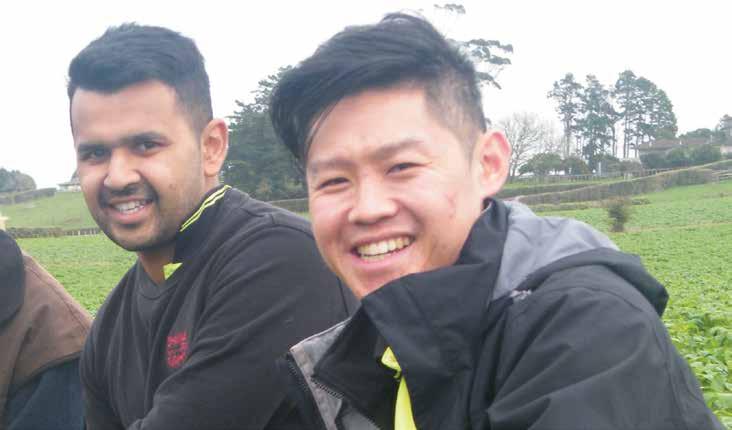
Spend a brief time talking to young Pukekohe growers and you will quickly learn their enthusiasm for their career in horticulture.
GEOFF LEWIS speaks to some of industry’s up and coming young talent on the attraction to and challenges of growing.
Jana Bhana is the latest generation of his family to carry on the vegetable growing legacy. He comes from the longestablished vegetable growing Bhana Family Farms in Pukekohe where he worked with his father and uncles as a child.
After completing a Bachelor of Business degree with majors in marketing and management through Auckland University of Technology (AUT), Jana took up a role with

T&G focussing on organics through a marketing project. While the role was good exposure to the range of jobs the sector has on offer, Jana’s deep connection to growing eventually led him back to his roots.
“After T&G I came back to the family farm where I felt a connection which renewed my passion for growing,” Jana says. “I was never attracted to office work. I like the diversity and opportunity offered by horticulture.”
Despite popular opinion, it’s a sector with a variety of roles, he says.
I love what I do. I love growing vegetables...
“When I tell people I work on the family farm they just assume I’m a spud digger, but at any time I could be doing anything from spraying, seeding and applying fertiliser, to harvesting or engineering,” says Jana. “This is much more satisfying than shifting paper. But there are times when I have to do desk work [too].”
Jana says he feels proud to be a New Zealander growing premium local produce. The importance of growers hit home for Jana three years ago when he toured Europe and saw Kiwi produce in overseas supermarkets. The challenge of supplying such markets with sustainable produce was also front of mind, particularly in the face of rising production costs, unpredictable weather and freight services.
“I know I speak on behalf of many young growers and even those in the pastoral sector – money isn’t the only reason why we’re in the industry, it is a passion to supply our country with world-class, fresh produce. But we also need to survive and make a return.’’
Jana says the mounting pressure on growers means many have exited the industry in recent years – making the task for those remaining harder, especially in times when produce is in short supply.

“I would like to see a far greater effort by government to understand the growing sector and consult before imposing policies, including Waikato Plan Change 1, restrictions around the use of nitrogenous fertilisers, changes to the minimum wage, Significant Natural Areas, the distance of cropping from waterways, the protection of elite soils from urban sprawl, and the introduction of new public holidays,” Jana says.
“For growers to be sustainable, employ staff, replace machinery and continue to grow has become tough. New legislation will impact on New Zealand’s food security and our exports. I love what I do. I love growing vegetables, but there is a point where young growers like myself will throw in the towel if nothing changes.”
Myles Fong, another grower hailing from a longestablished Pukekohe vegetable growing family, took a different path to his career in horticulture.
He decided not to go through academia.

“I considered going to university, but I went back onto the family farm,” Myles says. He and his brother Scott are third
generation growers in the family business, specialising in onions, cauliflower, broccoli, cabbage and snow peas, with the brassicas going to the local market and onions into domestic consumption and export.
With Dad, Allan Fong, looking towards retirement, Myles and Scott will be taking on day-to-day running of the operation.
Like Jana, Myles says while he loves growing, government policies have made things harder and bring into question the desire to carry on in the business.
I would like to see a far greater effort by government to understand the growing sector and consult before imposing policies
I know I speak on behalf of many young growers and even those in the pastoral sector – money isn’t the only reason why we’re in the industry, it is a passion to supply our country with world-class, fresh produce
“We have to employ people to keep up with government regulations,” Myles says.
Regulations and the environment are also top of mind for 25-year-old Sarah Dobson.
As A.S. Wilcox & Sons’ environmental and sustainability coordinator in Pukekohe, Sarah manages farm plans, looks at ways to improve environmental practices, and oversees compliance and trial work on a day-to-day basis.
“I’m not directly in crops but more associated with environmental projects, looking at contaminants, nitrogen leaching and farm planning,” Sarah says. “I aim to have a really positive approach towards environmental improvement.”
She says one of the biggest challenges for growers is keeping abreast of the changing compliance landscape, which requires her to keep her programme moving forward and be open to constant change.
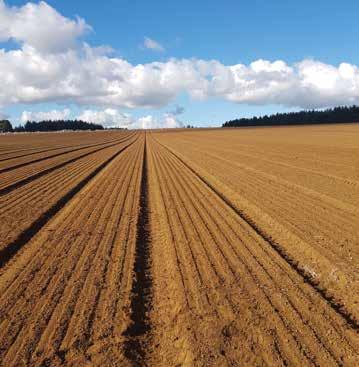
Sarah canvassed that “grower landscape” in a speech as a contestant in the 2022 Pukekohe Young Grower of the Year competition. She pitched what the year 2027 might look like for an onion grower, describing a future where compliance and stricter regulations were in place for the greater good: to safeguard the industry, ensure that growers’ produce is safe for consumers, to build resilience in the face of climate change and to ensure that growing operations are sustainable so that industry can continue doing what it does best – growing fresh, healthy and local food.
Sarah wowed the judges with her speech, taking out the regional title, and went on to place as runner-up at the national Young Grower of the Year competition in Nelson this September. Sarah also won 2022 Young Vegetable Grower of the Year.
Unlike Myles and Jana, Sarah’s horticulture expertise and exposure came a little bit later in life.
Growing up on a lifestyle block at Waiau Pa near Pukekohe, her association with commercial agriculture was minimal. “Still uncertain about what to do after high school, I talked to an external careers advisor, looking for something which included science and had a practical approach to global issues including climate change and feeding the world,”
Sarah says. “She suggested agriculture.”
Sarah enrolled in Massey University, earning her master’s degree in science over five years. She remembers she was the only student in her high school year to go Massey in Palmerston North – an institute known for its focus on agriculture.
“Once you get into horticulture you realise its complexity – it’s not just growing, picking and packing. I decided it could be a career.”
She says exposing people to the industry early on is critical when it comes to encouraging young generations to consider horticulture.
“Unless you are exposed to agriculture when you’re growing up it’s not really high in your mind [as a career],” Sarah says. “Horticulture is usually [only seen as] the traditional summer pick and pack work. It’s rare for people to decide that’s what they want to do. But once you’re past that you can see how rewarding it can be as a career.”
Sarah’s Master’s project on the impact of nitrogen fertiliser on potato flavour began her association with A.S. Wilcox and Sons Ltd. This included two summer internships before she completed her Master’s project and then gained fulltime work with the company.
“Although I lived near Pukekohe, I had never heard of Wilcox,” Sarah says. “I called, was given an interview and got a summer practicum position working on potato trials.” Today, Sarah says she is happy with her career choice and how she has progressed in her role.
“I really like the space I’m in, working on farm improvements, biodiversity plans, native plantings, the
I really like the space I’m in, working on farm improvements, biodiversity plans, native plantings, the complexities of water… I find [it all] very interesting
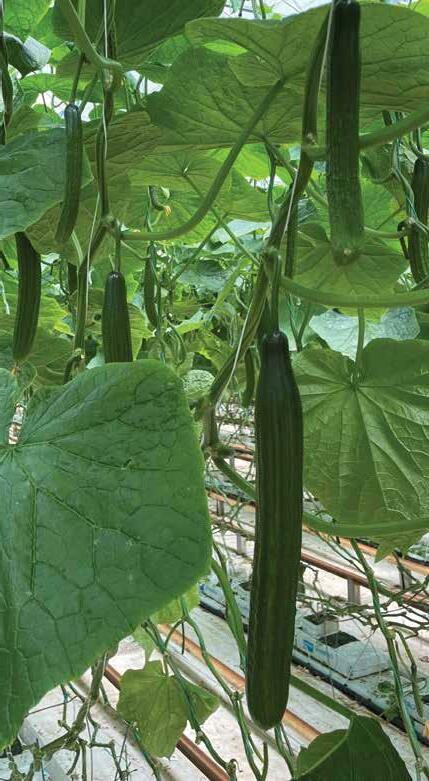

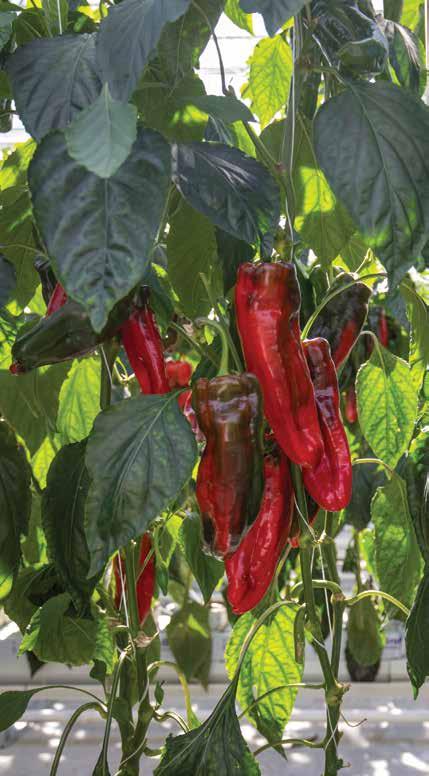

Over the last 20 years approximately 35,000ha of New Zealand’s highly productive land has been carved up for residential development and a further 170,000 converted to lifestyle blocks. KRISTINE WALSH speaks to growers on the government’s National Policy Statement for Highly Productive Land and how it affects them.
From the home designed under the eagle eye of his wife, Caroline, in the 1990s, Geordie Witters can see the hill country on which he farms sheep and beef, and in front, the rows and rows of citrus he grows on gentle slopes and flats.
Being on family land, it is a view he has enjoyed his entire life and one he is reassured to know will change little in the future.
Located on the fertile Poverty Bay Flats, just out of Gisborne, the gentler parts of the Witters’ property are protected under the local District Plan and can’t be subdivided into portions of fewer than eight hectares. Now, those protections are to become even stronger with the release of the government’s National Policy Statement for Highly Productive Land (NPS-HPL).
Announced in September, NPS-HPL represents years of work on how to support food security by offering enhanced protection for some of the country’s most productive land.
That’s important: only about 15 percent of New Zealand is categorised as highly productive – with just one percent rated at the highest level of productivity – and once built on, it is very hard to rehabilitate degraded soils.

The aim of the policy statement is to improve how we protect Highly Productive Land (HPL) from inappropriate subdivision, use and development.
“We need to house our people and to feed them, too… our cities and towns need to grow, but not at the expense of the land that’s best suited to grow our food,” Environment Minister, Hon David Parker, said during the announcement.

We need to house our people and to feed them, too… our cities and towns need to grow, but not at the expense of the land that’s best suited to grow our foodVegetables NZ chair, John Murphy
“The NPS-HPL will help protect our best growing areas, so Kiwis continue to have access to leafy greens and other healthy foods.”
Agriculture and Trade Minister, Hon Damien O’Connor, noted the significant economic and employment benefits to communities that stem from protecting HPL, as well as the food it provides for New Zealanders.
“[Highly productive land] underpins the value of New Zealand’s primary sector,” he said. “Once land is built on, it can no longer be used to grow food and fibre. That’s why we are moving to protect our most fertile and versatile land, especially in our main food production areas.”
While there has been a widely positive reception to the government’s National Policy Statement for Highly Productive Land (NPS-HPL), not all growers are on board.
Vegetables New Zealand chair, John Murphy, says up to half the growers he has spoken to are concerned about how the statement could impact on their businesses, now and into the future.

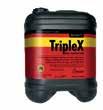
He says restricting the use of HPL could impact on its value and consequently make it harder to raise capital for operating purposes.
“The worry is that the net worth of the land a grower has purchased will be eroded,” John says. “If the value of land is capped because a regional authority limits its use and earning capacity, then the viability of growing could be impacted, and we don’t think that is addressed in the new policy statement.”
Vegetables New Zealand believes the intent of the policy was good, in that it addressed some issues around reverse sensitivity in the face of urban creep.

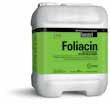
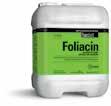

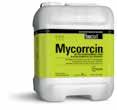

“What we are worried about is how the fundamental financial backing for growers could be eroded… there is no point in protecting HPL if we can’t afford to grow on it,” John says. “So, at this stage, it is important that we work with regional authorities to establish how they will enact the policy and ensure growers have some input into that.”
The feedback John received indicated growers were divided on their support for the policy, with strong feelings on both sides.
As chief executive of his family’s Marlborough garlic growing business, Murphy’s New Zealand, John manages 85 hectares of leased land.
Perhaps ironically, much of that is in Canterbury, as large tracts of HPL closer to home have been planted in grapes, which don’t need the high-quality soils his business requires.
The aim of the policy statement is to improve how we protect Highly Productive Land (HPL) from inappropriate subdivision, use and development
ONLY ABOUT 15 PERCENT OF NEW ZEALAND IS CATEGORISED AS HIGHLY PRODUCTIVE – WITH JUST ONE PERCENT RATED AT THE HIGHEST LEVEL OF PRODUCTIVITY
“In fact, we could actually benefit as this policy could keep lease prices down, so personally, I don’t have a dog in this fight,” he says. “My input is based on Vegetables New Zealand’s desire to ensure the voices of our growers are heard.”
He rejects the view of ‘greedy growers’ wanting to have it both ways by maintaining the right to carve up land, at the same time preventing it from being used for horticulture in the future.
“At the end of the day we are all trying to make a living for our families by maintaining viable vegetable growing operations,” he says.
“We are not confident that regional authorities are best placed to decide how land should be used. We think growers are best placed to do that.”
Other groups are worried that the policy is a little too late and will take too long to come into force.
“My concern is that it will take at least three-and-a-half years to implement and it relies heavily on co-ordination between authorities,” says Bioprotection Aotearoa director, Professor Amanda Black. “While it came into effect on 17 October 2022, any land already marked for subdivision will still go ahead.
“There are also a number of exceptions to protecting highly productive land that beg the questions: will the NPS be able to adequately protect our future food supply? And is this too little, too late?”
Horticulture New Zealand says that there is still work to be done to ensure growers can “sustainably and profitably” use highly productive land.
“HortNZ has advocated for nearly a decade for government policy that recognises the importance of our best soils and ensures that they are prioritised for what they are best for… producing healthy vegetables and fruit,” says HortNZ chief executive, Nadine Tunley.
that all land can be used and managed to best effect,” Minister Parker said. “In limited circumstances councils will still be able to rezone highly productive land for urban housing if less productive land is not available, or if certain tests can be met.
“However, the NPS-HPL will introduce strong restrictions on the use of highly productive land for new rural lifestyle developments.”
“All along we have said that, with good planning, New Zealand can have fresh vegetables and fruit, and houses.”
In its announcement, the government said the NPS-HPL would sit alongside other initiatives like the National Policy Statement for Freshwater Management and the National Policy Statement on Urban Development.
“This recognises that using land for primary production needs to occur within environmental limits and ensures
Before land can be protected it must first be identified, and as part of that local bodies are required to identify potentially HPL that is in a general rural or rural production zone; is predominantly Land Use Capability (LUC) 1, 2, or 3 classification; and forms a large, geographically cohesive area.
Using that information councils must, “as soon as practicable” – but no later than three years after the start date of 17 October 2022 – notify in their regional policy statement the parts of their regions that are to be mapped as HPL. Until this work is complete, the default definition of HPL is land covered by those LUC 1, 2 and 3 classifications, as set out by central government.
Like many of his contemporaries around the country, Gisborne District Council (GDC) environmental scientist, David Sluter, has a hand in that work by carrying out soil monitoring that will help paint the national picture.
David started testing last year at 12 sites in Gisborne – a number constrained by pressures caused by the Covid-19 pandemic – taking in sheep and beef farms, native vegetation areas, and a couple of sites used for cropping, such as maize.
But that number is ramping up, and for 2022 he has a programme of 36 sites to get to, with the aim of averaging out at 30 properties a year.
“That first year was a challenge but we’re now slowly working our way through the identified sites for what will be a five-year programme,” David says. “After that we plan to revisit the sites every five years so we can map any changes.”
At the end of the day we are all trying to make a living for our families by maintaining viable vegetable growing operations
HortNZ has advocated for nearly a decade for government policy that recognises the importance of our best soils and ensures that they are prioritised for what they are best for… producing healthy vegetables and fruit
The GDC says its region has some of the most elite soils in the country, but without monitoring them, it is not known what condition they are in, or how their use is impacting on surface and groundwater.
Its monitoring programme is not just about helping council meet its obligations under the new NPS-HPL… it will also act as an early warning system to identify any changes to the health of the soil.
Throughout the programme, the GDC’s Environmental Science and Integrated Catchments team will continue to visit sites from hill country to coastal lands to (naturally) the highly fertile Poverty Bay Flats.
David confirms that, to date, landowners have been keen to get on board.
“That’s because we are clear about what we are there for and how it will support the health of us all… we’re not there to wield a big regulatory stick,” he says.
“That’s something they’re interested in too, and over time they’ll be able to see and respond to their own results.”
For David, it is good use of the science degree he earned in Wellington, after he moved from the United Kingdom to New Zealand 15 years ago.
“I think my contemporaries all around the country are passionate about this work,” he says. “It could have benefits not just for our generation, but for generations to come.”
Read the National Policy Statement for Highly Productive Land online: https://environment.govt.nz/assets/ publications/National-policy-statementhighly-productive-land-sept-22-dated.pdf



THE GDC’S MONITORING PROGRAMME IS NOT JUST ABOUT HELPING COUNCIL MEET ITS OBLIGATIONS UNDER THE NEW NPS-HPL… IT WILL ALSO ACT AS AN EARLY WARNING SYSTEM TO IDENTIFY ANY CHANGES TO THE HEALTH OF THE SOIL.

Around the country, local bodies are taking different approaches to meeting their obligations under the new National Policy Statement for Highly Productive Land.
In August of this year, for example, Hastings District and Hawke’s Bay Regional councils joined forces to hold a symposium to explore issues around the highly productive land of the Heretaunga Plains and beyond, and its value to growers, producers and the wider economy.
A growing population has driven urban expansion, putting irreplaceable soils under houses, factories, concrete and tarmac.
At the time, Hastings mayor Sandra Hazlehurst said Hawke’s Bay was the largest apple-producing region in the country, and the second largest wine producer after Marlborough, demonstrating the importance of the Plains to horticulture and viticulture and of those industries to her region.
Economic success has created pressures and threats to the land resource, she said, so the region has had to develop strategies to determine how growth would be managed, and soils protected, for the future.
The region’s soils took nature millions of years to create, added Hawke’s Bay Regional Council chair Rick Barker.
“They are nature’s gift that must be protected… we humans cannot create them, and they won’t come again. These soils fuel our horticulture, viticulture and agricultural sectors. It’s on these soils that we have built our wealth.
“A growing population has driven urban expansion, putting irreplaceable soils under houses, factories, concrete and tarmac. If this expansion doesn’t stop we will have smothered the goose that lays golden eggs.”
Local governments must protect these irreplaceable soils by redirecting development elsewhere, he said.
“Protecting the environment and these fertile soils has to be a non-negotiable, no compromise, number one priority transcending any and all the individual interests of developers and landowners.
“We must accept that we individually are temporary guardians of the land, and that the land will be here for countless generations to follow. Our gift to future generations must be the land in its best state of preservation.”
https://environment.govt.nz/assets/publications/National-policystatement-highly-productive-land-sept-22-dated.pdf
If this expansion doesn’t stop we will have smothered the goose that lays golden eggs
New Zealand’s Land Use Capability (LUC) classification has eight classes starting at number 1, the elite soils that make up just one percent of the country, to the mountain lands qualifying at number 8.
According to Landcare Research, versatile soils – those with the fewest limitations to their use –fall into LUC classes 1, 2 and 3.




LUCs 1 and 2 cover around five percent of New Zealand, while LUCs 1, 2 and 3 cover about 14 percent, and much of that land –like that in Pukekohe – is close to major urban centres.

It is that land, with LUC classifications of 1, 2 and 3, that will be protected under the new National Policy Statement for Highly Productive Land.
https://ourenvironment.scinfo.org.nz/maps-and-tools/app/

On a gentle slope a short drive from the village of Clevedon, sits one of two strawberry farms run by Kevin and Diana Gallagher. HELENA O’NEILL speaks with Diana about her passion for the strawberry patch.

As spring begins to take hold in the Auckland region, a backroad on the outskirts of Clevedon village sees an increasing flurry of traffic – especially on weekends, with the second week of October marking the beginning of the harvest season for Clevedon Strawberries. What began as a relatively unknown berry operation is now a firm favourite among locals, the business also holding a regular stall at the popular Clevedon Farmers’ Market. Clevedon Strawberries operates two sites – the original site at Clevedon and a second just a short drive away at Ardmore. The Gallaghers were initially in partnership with their next-door neighbours until 2019 when the neighbours opted for retirement, Diana says.
In 2014 they planted 600 strawberry plants as a trial, digging and raking the mounds and hand-laying the polyethylene.
“We thought, ‘wow, this is pretty cool’ and so the next
we went all out and planted 80,000 plants, not really knowing what we were doing,” Diana says. “We didn’t have the infrastructure in place, the shop was in the process of being built, it really was trial and error.
“We took stock after that first year and decided that was too big, reduced planting to somewhere between 40,000 and 50,000 in the second year. That was more manageable as far as harvesting and selling the fruit.”
Clevedon Strawberries operates two sites – the original site at Clevedon and a second just a short drive away at Ardmore
year
In 2019, Diana and her husband Kevin began leasing additional land at Ardmore, the site of the former Strawberry Corner business.
“We approached them about buying the big strawberry [sculpture] as the land had been sold and it was no longer going to be a strawberry farm. The new owner said his daughter really loved the big strawberry and wanted to keep it. Before we knew it, we were talking with them around planting there as well.”
Initially the couple planted a small number of strawberry plants to test the logistics of operating two different sites. Diana says they have increased planting over the following two seasons and now have a total of 110,000 strawberry plants across both sites. The patches on each site cover one-hectare each, with 95,000 plants of the Camarosa strawberry variety and the remaining 15,000 in Albion.

“There’s a lot of driving in between the two sites,” Diana says. “Ardmore has a bigger packing area so picking can be done at our Clevedon site with fruit transported over there for packing. It has come down to getting people in to manage the shops because Kevin does work a full-time job and then works here for the weekend.”




Diana says she doesn’t know many strawberry growers but Francie Perry of the former Perrys Berrys was “a bit Camarosa

of a mentor” for the couple. Francie spent 40 years in horticulture and ran one of the country’s biggest strawberry operations until frustrations with Covid-19 restrictions led her to close the business.
“We used to buy all our plants through her until she shut down last year,” Diana says. “Even now we still ring her to pick her brains. She has such a wealth of knowledge and she’s been really good to us. But on the whole, it’s more us working it out as we go along. We don’t know if what we’re doing is the textbook way, but it’s what works for us.”
Even after eight years running the business, the couple is always learning about growing strawberries.


Towards the end of November, Clevedon Strawberries opens the two patches to the public for pick-your-own berries.
“With strawberries because it’s such a short season, everyone loves them, goes crazy for them. I still am even to this day, in awe of picking a beautiful strawberry.”
Sourcing enough staff remains the biggest challenge for the business.
“Being seasonal you lose them all and then you readvertise next season,” Diana says. “I tend to have brand new staff each season apart from a couple of people coming back.
“How our season falls with it beginning in October, we have been reliant on a lot of university students, but they’re not available until the beginning of November. So we have about a month where we struggle to keep all roles covered. It doesn’t help that each year we have got a little bit bigger.”
The couple also have a long-standing handyman, Pete, who helps keep the farm running smoothly.
The season usually wraps up by late January, with the next few months spent preparing the soil for replanting. Come planting time in May, pukeko prove to be a big pest, pulling out the young plants.
“We can go back the next day and replant a whole row because they’ve pulled them all out,” Diana says. “The plants are quite hardy so you can replant them.”
Humidity throws another challenge, causing brown rot that requires fumigation. Twice the operation has battled spider mite.
“We didn’t really know what we were looking for when that happened,” Diana says. “One area of our patch looked like someone had poured hot water on it… it was the first time it had happened. Someone said to us that we had spider mite in there.”
Fumigating for spider mite means three stand-down days before fruit can be picked.
“If we think there is any hint of spider mite [now], we are in there with a magnifying glass looking for them,” Diana says.
Fruit is sold through the two on-site shops, at the Clevedon Farmers’ Market, Clevedon Superette, and as of this season, a second caravan based at Botany Town Centre. The couple bought their first caravan in 2018 as a mobile shop selling fruit in harvest season, along with coffee and real fruit ice creams all-year-round, as well as strawberry waffles.
“We started the real fruit ice creams at the beginning,” Diana says. “We decided to keep it simple; the strawberries
are the core but the real fruit ice creams, so many people just travel miles for it. They just love it. They will queue for it.
“It’s an opportunity for us to have almost zero wastage. All the seconds that we get or don’t sell through the shop, we chop them and freeze them and that’s what we use for our ice cream.”
With a stockpile of their own-grown frozen berries, they can keep their ice cream caravan at the Clevedon Farmers’ Market all through winter.
“People still love to eat a real fruit ice cream all through winter,” Diana laughs.



The caravans also allow the business to support local events and can even be hired for birthday parties.
Diana says a small number of berries are sold through The Produce Company to supply a few Auckland restaurants. Clevedon Strawberries also produces its own jam and strawberry vinegar made offsite by a chef.




As the business has evolved, it has attracted preschool and school visits as well as social clubs. Diana offers a brief talk about growing strawberries and their business journey.
“I could talk people’s ears off about it,” she laughs.
Despite the busy spring and summer months, Diana still loves running the business with Kevin.
“It’s like having a baby, you go through all this pain and then you forget it,” she says. “And then you go and do it again. We know how busy we get, we know how hectic it can be, we know we’re going to struggle to get staff, and we know we have to worry about the weather, but we do it again.
“We are super proud of what we’ve done, and we’re super proud about our strawberries and what we produce every year.”



The intensive field trial stage of the Sustainable Vegetable Systems (SVS) programme is nearly at an end, with most of the four rotations growing a final ryegrass cover crop. The data being collected from these trials is being used to develop the nitrogen model. Discussions and workshops are currently underway to determine the form(s) that the final nitrogen management tool, built around the model, will take. Meanwhile, the regional monitoring in nine grower paddocks continues to gather data from across the country. This data will be used to validate the model predictions, as well as being used in comparisons with other existing tools. This work will continue through to 2024.
SVS is now just over halfway through the project, resulting in a transition from trials and data collection into analysis, modelling and development of the tool. Now that we have
more to demonstrate, this portion of the project will also see greater levels of engagement with the wider grower community and other industry stakeholders. There will be a focus on case studies across a variety of vegetable growing operations in order to determine the industry requirements and therefore the development pathway, for the nitrogen management tool.
SVS is now just over halfway through the project, resulting in a transition from trials and data collection into analysis, modelling and development of the tool
As part of the engagement process, we have just wrapped up filming four short videos. Currently being edited, the videos will be released in November. A Community of Practice group has also been established, consisting of growers and agronomists, to give feedback and inform the development of the nitrogen management tool.
The experimental set-up of the intensive field trials involves a comparison between four nitrogen fertiliser rates:
• no nitrogen
• the Technical Panel (TP) recommended N rate
• half the TP recommended rate
• double the TP recommended rate.
There are also two rates of irrigation applied: Good practice based on soil moisture monitoring; and double that rate to ensure we get some nitrogen leaching (it is a trial after all).
The trial involves collection of data on crop biomass, soil testing, and nitrogen leaching.
Generally, the following trends were observed across many of the crops within each rotation:

• Crop N uptake increases with N application rate, though this is highly crop dependent
• Crop N content (% N) increases with N application rate but is less variable between treatments than overall N uptake
• The N content in crop residues increases with N application rate
• Soil mineral nitrogen content is higher in higher N treatment plots.
None of this is revolutionary, however we need the numbers to ensure the model and subsequent management tool is robust.
• Soil mineral nitrogen flux can only be accurately assessed when a whole rotation is considered, as the soil and crop in a single crop growth period can be influenced substantially by the previous crops grown in the same field. Leaching during a crop growth
period is often the result of fertiliser or residues from the previous crop.
Luckily, we called the project Sustainable Vegetable Systems, to reflect that there are no good or bad crops, but that all crops are part of a rotation.
• Leached nitrate increases with N application rate, though baseline leaching from residues and soil mineralisation (rates of which increase after tillage between crops) often contributes a significant portion of total leaching.
Therein lies one of the biggest unknowns. The contribution that crop residues and covered crops make to the mineral nitrogen pool of the following crop can be significant. Without question that is an area for further analysis over the next few years. In the interim we have estimates about plant residue contributions (read on), and soil nitrogen testing is the ultimate source of truth. Soil nitrogen testing will show if we are deviating from the planned nitrogen
Comparing the results of the field trials to the regional monitoring has shown some interesting correlations. An example of this is observed increases in soil mineral nitrogen during onion crop growth, observed both in the field trials and at two regional sitesRotations and crops grown in Workstream 1. Rotations are based at Plant & Food Research Ltd farms at Lincoln and Hawke’s Bay Rotation 1. Canterbury Potato – Onion rotation Rotation 2. Canterbury Vegetable rotation Rotation 3. Hawke's Bay Onion rotation
levels, either caused by climate factors like rainfall, or different than anticipated crop breakdown or soil N mineralisation rates.
While many of the results above were to be expected, several outcomes from the trials have provided interesting implications for nitrogen management by growers. The quantity of soil mineral nitrogen build-up, and resultant leaching, that occurs from crop residue breakdown and soil mineralisation generally constitutes a much larger fraction than that resulting from fertiliser application. The quantity of nitrogen released from residue breakdown further reinforces the necessity of viewing nitrogen management from a rotational perspective rather than from an individual crop timeframe. This nitrogen source will provide opportunities to reduce fertiliser inputs. With time – and growers’ own measurements – confidence will be built in just how much residue breakdown and soil nitrogen mineralisation contributes to meeting a crop’s nitrogen requirements. It is hoped that the SVS tool will build grower understanding and confidence by making some of these invisible nitrogen flows visible.
Comparing the results of the field trials to the regional monitoring has shown some interesting correlations. An example of this is observed increases in soil mineral nitrogen during onion crop growth, observed both in the field trials and at two regional sites. This might be occurring due to high residue nitrogen from previous crops, or high mineralisation during the summer months.
With the model under development, the nitrogen management tool that is underpinned by the modelling is emerging. The most important considerations for the programme leaders when designing the tool has been the user experience. If the tool does not fit the needs of users with its input options, its outputs, or its accessibility then it will not be taken up by growers and advisers. Therefore, a key priority has been to engage with the anticipated users – being growers, agronomists, and other technical advisors – to determine what their requirements are and to better understand their processes behind nitrogen management decision making.
To this end a Community of Practice was established, consisting of a dozen representatives from growers and technical advisors. This group had its first meeting in September, where the tool was demonstrated in its current
state and compared to other nitrogen tools. Feedback from the meeting has been instrumental in planning the development of the tool.
Plans were also made in this meeting to develop case studies on participants’ operations using the early prototype tool. These will be prepared over summer and autumn, with the case studies being used to further refine the tool and to support growers when the next version of the tool is released in July.
The other outcome from the formation of this group has been the development of a nucleus of experts and champions within the industry who are thinking about nitrogen mitigations and overall nitrogen management strategies.


Much of the energy of the SVS programme is now being directed towards the model and tool development. This will involve all of the workstreams, with tasks ranging from software development and coding, through to industry engagement and building case studies.

The upcoming summer also promises some warm work for the regional monitors, as they continue to collect samples used in validating the model.
In November, a series of informative short videos will be released, covering topics from the project itself through to grower available technologies like the Nitrate Quick Test.
If you have feedback from a grower’s or agronomist’s perspective, please contact Gemma.Carroll@potatoesnz.co.nz
With the model under development, the nitrogen management tool that is underpinned by the modelling is emerging

The climate driver La Niña is set to strike for the third consecutive year and will influence our weather patterns in the months ahead – an occurrence called a “triple dip.” While it is an unusually long time to have the phenomenon at play, it is not unprecedented. The last triple dip event occurred between 1998 and 2000.
So how does La Niña affect our climate?
There is a saying often used by climate scientists and meteorologists when asked about what La Niña (or El Niño) means for the forecast: “we know the average outcome of La Niña, but no single event is average.”
On average, easterly and north-easterly winds tend to become more common during La Niña, bringing moist, rainy conditions to north-eastern areas of the North Island and reduced rainfall to the lower and western South Island. Warmer than average sea and air temperatures generally occur, except in the east of both islands where onshore winds bring more cloud, keeping nights cool and daytime highs subdued.
Just like we know that the average drive time between Auckland and Hamilton can be influenced by a crash or heavy traffic, our 2022 weather to-date has been strongly influenced by La Niña driving along Mother Nature’s highway. There are other climate drivers on the road too, and even the chance of an atmospheric traffic jam to consider. For example, a negative phase of the Indian Ocean Dipole (IOD – a sea surface temperature seesaw in the Indian Ocean) over the last few months has been associated with greater moisture availability for low pressure systems in the wider Australasian region. This has contributed to recent flooding events here and across the ditch – as many growers would have experienced. The IOD is set to ease from November to December though, and then take an off-ramp while other climate drivers move onto the on-ramp.
Tropical cyclone season officially runs from November to April and typically, at least one ex-tropical cyclone passes within 550 km of New Zealand each year. The recently released Southwest Pacific Tropical Cyclone Outlook1 for the coming season considers the risk for an ex-tropical
cyclone affecting New Zealand to be near normal to elevated. Extreme events like this can bring a month’s worth of rain or more in just a day or two. We know from previous events that there is a near-equal probability of an ex-tropical cyclone passing to either the east or west of the North Island.
To understand what the season ahead may hold we need to consider all the climate drivers at play, as well as the impact of an already warmer climate on these.
When NIWA scientists get together to update NIWA’s Seasonal Climate Outlook2 each month, there are three broad areas of discussion. To start, we always look in the rear-view mirror. What has happened to date? How is it progressing and does it match up with expectations? You can then turn your attention to the front windscreen. Several sophisticated computer models consider a range of data that describes what is happening now and use that information to project forward. As the saying goes, “all models are wrong, but some are useful.” As meteorologists, we combine our knowledge of how the earth system works, with our understanding of what the models show. When did a model last update and did it pick up on the atmospheric traffic jam that recently developed? Should we ignore this model as it drives poorly in wet conditions? Are they all taking the same route to Hamilton or are some veering off and going to Tauranga?
Another tool in the prediction toolbox is analogues – past seasons that had similar climate drivers. These can be both objective (automatically chosen based on a set of criteria) or subjective (chosen by an expert). While the official summer outlook won’t be released for another month, Figure 1 shows three plausible analogues of air pressure for our summer ahead. Broadly, we expect more east to north-easterly winds than normal, with higher than usual pressure to the south and lower than usual pressure to the north-west. However, the nuance is in the detail and we’re yet to see exactly how those pressure systems will line up.
The most recent analogue in the mix is the summer of last year.3 It was our fifth warmest summer on record. Summer rainfall was highly variable and featured extended dry spells alongside extreme rainfall events (two ex-tropical cyclones affected the country).
Summer 1998/99
Summer 2010/11
Summer 2021/22
Summer 2021–22 temperature difference from average (left) and rainfall difference from average (right). Note that the average period for comparison is 1981–2010
A common feature of La Niña in New Zealand is marine heatwaves. These can provide extra fuel to our climate drivers. Warmer than average seas keep nights warm on land – especially in coastal areas – and provide a warmer start to the day, allowing daytime highs to get higher than usual. Marine heatwaves can also invigorate incoming storms, adding both energy and moisture. Coastal waters near the north and west of both islands are already warmer than usual for the time of year, and we expect this trend to continue as we approach summer.

There are always ‘winners’ and ‘losers’ to any climatic pattern. It really depends where you are and what you’re doing (or growing). Last year, late summer rain for Hawke’s Bay affected apple crops and led to blueberries splitting during harvest, but apples in the South Island had a good season. Many grape growers prepared for humid and wet conditions by opening up canopies to increase airflow. Disease pressure was still an issue, but the impact was minimised.
Harnessing forecasts, from weather to seasonal climate, and using them to plan and prepare as best as possible is key. And don’t forget that we must all expect the unexpected while travelling along Mother Nature’s highway – hazards may pop up that require us to be agile and shift course. Although forecasts are much more accurate than they were a few decades ago and continue to improve all the time, they will never be perfect. Construction is ever-present on this highway.
The November to January Seasonal Climate Outlook is due to be released on 28 October and will be accompanied by a video and livestream on our Facebook page discussing the drivers along the highway that leads to summer.
1 https://niwa.co.nz/climate/southwest-pacific-tropical-cycloneoutlook/southwest-pacific-tropical-cyclone-outlook-october-2022 2 https://niwa.co.nz/climate/seasonal-climate-outlook

3 https://niwa.co.nz/climate/summaries/seasonal/summer-2021-22
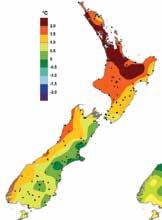

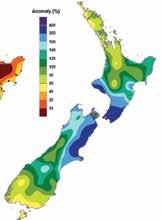
Predictions of temperature, rainfall, soil moisture and river flows.
niwa.co.nz/outlook
Air pressure anomalies (differences from average) for three analogue La Niña summers. Red colours indicate higher than normal pressure while blue areas show lower than normal pressure


Last year I was successful in being awarded one of AGMARDT’s leadership scholarships. Rather than being a prescriptive course, for which you submit a detailed application on what you’ll spend funding on, the AGMARDT leadership scholarship offers flexibility in how the applicant will utilise the funds. One of the activities included in my application was inmarket experience of the Netherlands.
I wanted to visit the Netherlands to learn more about:
1. Environmental regulatory changes
2. Farmers’ perspectives on the changes
3. Industry association structures
4. Industry structures (growers, packers, exporters)
5. How research is conducted

6. Issues and opportunities for Dutch onion growers
7. Effects of the Russia–Ukraine war on producers.
Although mainstream media in New Zealand is not reporting on the farmers’ protests in the Netherlands, it is a significant deal. At the heart of the issue is the way the European Commission passes and adopts new legislation. Because the legislation is passed in Brussels and then implemented in each of the member states and countries, if the country is at the extreme end of the regulatory reform – as is the Netherlands – this makes it extremely difficult to implement. For example, if a new regulation is passed into law with 24 countries easily able to meet the requirements, that law comes into force even if the other European Union (EU) countries cannot meet those requirements. This has become an issue for Dutch farmers in terms of the amount of manure allowed to be spread on farms, access to agrichemicals and the ‘nitrogen crisis.’
The Netherlands Ministry for Agriculture, Nature and Food Quality released its long-awaited plan to reduce nitrogen greenhouse gas emissions in rural areas on 10 June in an attempt to address the nitrogen crisis. The plan takes a distinctly regional approach to implementation, setting out
a scaled emissions reduction target across the country, including in ‘vulnerable areas.’ Under this plan, nitrogen levels are required to be reduced by up to 95 percent.
With the agricultural sector accounting for 45 percent of nitrogen emissions, the sector is under pressure to make significant changes to reduce emissions. The government will draw on the 25-billion-euro Nitrogen Fund to help farmers (voluntarily) quit, relocate or downsize their business and improve sustainability of these operations. The Minister of Nature and Nitrogen Policy, Christianne van der Wal-Zeggelink, says she is expecting one-third of the Netherlands’ 50,000 farms to disappear as a result of the plans.
For manure specifically, the Netherlands has previously had an exemption from Brussels around the quantity allowed to be spread back onto farms, due to the size of the dairy sector and the constrained size of the Netherlands. However, this exemption has not been renewed by Brussels. The current spread of manure is three times higher than Brussels allows. As a result, Dutch farmers are having to truck manure across the border to other countries so as not to exceed their cap.
Farmers are rightfully frustrated. The main issue is that Brussels conjures up the ideas, yet are quite detached from the farming community. If they have enough votes in support of the proposal, it carries. With the United Kingdom exiting the EU, the balance of power has moved away from Germany and the Netherlands to eastern and southern countries.

With all the pressures on farmers right now, this hard stick approach to nitrogen issues has not helped. Farmers and growers feel that the Netherlands implements the EU regulations to the letter of the law, whereas some other countries are perhaps a little more relaxed in their interpretations. This was specifically mentioned around access to agrichemicals, where growers felt more southern countries are not implementing the bans on chemicals fully.
As a result of the proposed reforms, farmers have been protesting in record numbers. It has become a whole of agriculture movement, not simply a fringe movement. All along the countryside are signs in support of farmers. They have also put the Dutch flags up along the roadsides upside down, in the form of a visual protest.
One of the issues in the Netherlands horticulture sector (in my view) is that growers don’t always have representation around the industry bodies. Instead, the industry bodies are managed by packers and exporters – particularly for onions. This reduces the ability of growers to easily engage with regulators.
For example, one of the equivalent organisations to Horticulture New Zealand in Holland is the Fresh Produce Centre. The Fresh Produce Centre has 320 members, typically comprised of cooperatives, or industry associations such as Holland Onions. It is a good way to ensure they have representation across the sector by having other industry associations as members, but it creates distance between growers and the association. Holland Onions itself only has packers and exporters as members, so again, not an avenue for growers to have a voice.
The Dutch onion sector is geared towards exports, with over one million metric tonnes of onions exported annually. The industry is structured around large packhouses, with high volume throughput. In Holland there are 3000 onion growers, 40 packers and a similar number of exporters. This has led to packers primarily undertaking the support for growers. Some of the packers in the Netherlands are packing nearly 20 percent of the Dutch crop, amounting to around 220,000 tonnes of onions – the equivalent to New Zealand’s entire crop. This volume has allowed them to specialise in this service and be cost effective; i.e., they just need to take a small commission per tonne packed. There are some vertically integrated growers, packers and exporters, but it is not overly common.
With all the pressures on farmers right now, this hard stick approach to nitrogen issues has not helped
My preconceived idea was that research would be commissioned similarly to how it is in New Zealand –a mixture of Crown Research Institutes, grower associations and private researchers. However, the Dutch system is typically led by the universities, including the likes of Wageningen University, and large multinational corporations. For example, the onion sector in Holland has a programme of research called Eureka. This programme was designed by Wageningen, which provides the project management support. It is co-funded by multi-nationals, the University, the Dutch government and a small contribution from Holland Onions. This makes the research more feasible than in New Zealand where the lion’s share of the financial contributions come from product groups and the government.
It is hard to compare however, as Wageningen University & Research alone is turning over 1.5 billion euros ($2.7b NZD). Having such a large university has created a hub for primary sector innovation, with multi-national corporations such as Unilever being on campus to tap into the global expertise available. For example, the university is currently searching the world for wild allium species showing resistance to Fusarium, downy mildew and other diseases to cross-breed into commercial onion varieties.
• Water salinity: One of the issues the Dutch growers are facing is the salinity of the water in its core growing region, Zeeland. This issue is paramount in years when rainfall is not adequate, like this year.
• Agrichemicals: The determination to halve the number of agrichemicals in the EU by 2030 is starting to cause significant headaches for growers. There is an expectation that Maleic hydrazide will be banned in 2028 when it is next up for review. There is already a large programme of research to look at alternative storage protocols and to identify the genes which turn on and off onion dormancy.
• Land values: Like New Zealand, the price of land in the Netherlands is rapidly appreciating. While New Zealand has pockets of high rural land prices, in Holland land is still higher on average, and there is greater population density.
• Africa: The population of Africa is 1.4 billion people and growing at 2.6 percent per annum. Coupled with this is a high economic growth rate and an extremely high onion consumption rate ranging from 9kg in South Africa to 44kg per person in Niger. If we take 20kgs as the average, this means every year they need an additional 728,000 tonnes of onions.
• Automation & AI: With the increasing cost of labour and wages, the Netherlands horticulture sector recognises artificial intelligence (AI) and automation as an integral part of the sector’s future. Some packhouses are almost entirely automated in the Netherlands now.
• Shipping rates: With high inflow of containers into Dutch ports with imported products for continental Europe, the onion sector benefits from being able to access cheaper rates to export out of Europe, compared to New Zealand shipping rates.
Energy: The effects of the war between Russia and the Ukraine on European producers is becoming acute. The main issue is, of course, the cost of energy. It is impacting not only the glasshouse and indoor cropping sector, but also the cost of cool storage and transportation. Anecdotally, one tomato grower sold their three-year contract for energy for 42 million euro and retired. Those with floating rates have been extremely hard hit. Some onion growers are also looking at the cost of storage and questioning whether it is better to sell now at a high price or store the onions for six to eight months.
Inflation: The Russia–Ukraine war is driving up the cost of inputs in the EU, similarly to in New Zealand. However, this is going to be more profound than in New Zealand.
Crop Selection: The price for arable crops is also increasing significantly in the EU, and some growers are deciding to plant arable crops rather than vegetables. This may be particularly true in countries such as France and Spain, which may actually see a considerable reduction in plantings for vegetables.
Overall, it was an extremely interesting time to visit Europe and understand the implications of some of the decisions being made. I am extremely grateful to AGMARDT for the support, and recommend others look at the scholarships and funds available through the AGMARDT website.
WITH THE AGRICULTURAL SECTOR ACCOUNTING FOR 45 PERCENT OF NITROGEN EMISSIONS, THE SECTOR IS UNDER PRESSURE TO MAKE SIGNIFICANT CHANGES TO REDUCE EMISSIONS

The Canterbury Potato Liberibacter Initiative (CPLI) is a programme created and funded by a committee of Canterbury growers and processors, with in-kind support from Potatoes New Zealand.
CPLI was formed in August 2021 by like-minded farmers and industry representatives to combat the devastating impact of the Liberibacter (Lso) bacterium which causes Zebra-chip in potato crops.
There are multiple projects running within the programme and Potatoes NZ are delighted to benefit from the enthusiasm and fresh energy of Masters students and PhD candidates conducting the research for us at Lincoln University.

Tomato potato psyllid (TPP) is native to North America and is found all over Mexico, western United States and some Canadian provinces.
Tomato potato psyllid (TPP) is native to North America and is found all over Mexico, western United States and some Canadian provinces
Tomato potato psyllid (Bactericera cockerelli) was officially recorded in New Zealand in May to June 2006, although it is believed to have been in the country prior to the
summer of 2005–2006. The decision was made not to attempt eradication, as it was widespread over both Auckland and Taupo areas. Over the next three years, TPP spread fast throughout New Zealand.
By 2008 TPP could be found all over the country in Northland, Wellington, Wanganui, Hawke’s Bay, Gisborne, Canterbury and Dunedin (Teulon et al., 2009).
There are four biotypes of B. cockerelli, western, central, northwestern and southwestern. Western biotype is present in western Australia, Norfolk Island and New Zealand. Western biotype is the only biotype present in New Zealand. Northwestern biotype is found in Oregon and Washington, this is also where zebra chip was first identified. Southwestern biotype is only found in New Mexico and parts of Colorado.
TPP currently creates major challenges for tuber quality and plant growth. This has major economic impacts on the New Zealand Potato Industry’s processing sector.

‘Psyllid yellows’ and zebra chip are caused by the phloemlimited, gram-negative bacterium, Candidatus Liberibacter solanacearum (CaLso).
There are five haplotypes (genetic types) of CaLso, (A though E), but only haplotype A is present in New Zealand. The major difference between CaLsoA and other haplotypes, is that plants infected with CaLsoA do not die from the bacterial infection, but will grow at a much slower rate, as well as developing tuber defects.
CaLso is an obligate parasite which is only able to multiply within eukaryotic (multicellular) hosts. The bacterium has yet to be cultured in vitro. It is seen to be highly adaptive at evolving to new plant species in response to changing vegetation and environmental factors.
We can be very grateful that other haplotypes are not present in New Zealand and we aim to keep it that way.
CaLso symptoms are stunted growth, leaf chlorosis (yellowing), leaf discolouration, swollen internodes, proliferation of axillary buds, and the aerial tubers and vascular system turn brown (Haapalainen, 2014).
Below ground is where the real damage is seen, and this impacts the economic sustainability of the crop. Tubers develop brown lesions in the vascular ring, necrotic flecking on internal tissues and streaking of medullary ray tissues (from the pith to the cortex). Infected tubers have shown decreased starch levels and increased levels of host derived phenolic compounds, amino acids, and salicylic acid, while upper stems of the plants have higher than typical starch and tuber-specific proteins. The discolouration of the tuber flesh results in rejected tubers as waste product at the processing plant.
There are five haplotypes (genetic types) of CaLso, (A though E), but only haplotype A is present in New Zealand
We can be very grateful that other haplotypes are not present in New Zealand and we aim to keep it that way
‘Psyllid yellows’ is caused by all TPP and is worse in the nymphal stage as they release higher amounts of the toxin. Nymphs are approximately 2mm long and flat. They commonly feed on the underside of leaves, and in the process can also transmit Candidatus Liberibacter. Psyllid adults, which are 2–3 mm long with four wings, feed by sucking the phloem sap using a special mouthpart called a stylet. Adult TPP can fly more than 1 km unaided by wind, but may be carried extremely long distances on prevailing winds.
considered the more attractive. In order to reduce error, Y-tube testing requires that 20 TPP be allowed to choose by leaf or product.
From June to August 2022, the population of TPP in the greenhouse unexpectedly mimicked what has been observed in the field, namely a massive drop in numbers on overwintering hosts.
There are currently around 100 products waiting to be tested, including a range of carbohydrates, amino acids and other volatile compounds. Multiple potato varieties will also be tested at different stages of plant phenology (life cycle).
The lure has the potential to help attract insects away from the cropping system and act as a trap, but with further refinement may well be able to distract the insects from returning to the potato crop, which hopefully results in their expiration, without them ever laying an egg on the potatoes.

Researchers at Lincoln University are currently investigating TPP adult preferences for different food grade products as well as different potato variety leaves ranging from healthy, to those displaying ‘psyllid yellows’, to determine whether there are any preferences to volatiles, including those produced by plants.
The Y-tube is used for choice testing. Individual TPP adults get the option of two substances and the one they pick is
Trap blueprints provided by Dr Rodney Cooper of the United States Department of Agriculture – Agricultural Research Service (USDA-ARS) in Wapato, Washington State have been modified to act as traps as well as lures. Prototypes have been printed using 3D printers and are already being installed at three hotspots in Canterbury to test their ability to catch TTP adults. They will be tested against yellow sticky cards to ensure they are comparable. One of the advantages of the traps is that they are TPP specific and will preserve the insect Deoxyribose Nucleic
‘Psyllid yellows’ is caused by all TPP and is worse in the nymphal stage as they release higher amounts of the toxin
Acid (DNA) as well as its gut content. This will help with determining feeding host plants, as well as TPP distribution behaviours.
The Y-tube is used for choice testing. Individual TPP adults get the option of two substances and the one they pick is considered the more attractive
The bulk manufacture of the traps is underway, and these will be distributed to key growers over summer in Canterbury.

We hope to be able to reduce the overall pressure on the crop as well as reduce the total number of full cover sprays needed to control TPP in the field.
To find out more about this work you can visit the CPLI programme page https://potatoesnz.co.nz/rd-project/ canterbury-potato-liberibacter-initiative or contact PNZ info@potatoesnz.co.nz
Special thanks to Kate Braidwood and Clive Kaiser from Lincoln University for providing this content.
This spring has seen the passing of two lifelong industry stalwarts.
Colin McDonald, ‘patriarch’ of the seed potato company Alex McDonald Ltd, was at the forefront of the New Zealand seed potato industry.
Colin and his brother Alistair brought the Scottish seed potato system to this country in the early 1970s. Together with Nelson Pyper, they formed a joint venture with the Department of Scientific and Industrial Research (DSIR) – now Plant & Food Research Ltd – and developed the pathogen tested “PT” Seed Potato Certification Scheme. This revolutionised New Zealand’s potato industry. Instead of growers selecting and saving their own seed, stem cuttings and tissue cultures were used to form the pyramid multiplication system.
Seed quality and yields improved, which led to higher
returns to both seed growers and end users.
In the 1980s, Colin imported the variety Nadine and when commercial potato washing began, Nadine sales increased year on year, and for the next 30 years Nadine was the premium washed potato in the New Zealand market.
Colin received the Queen’s honours for services to Agriculture, being appointed an MNZM (Member of the New Zealand Order of Merit) in 2010. As the honours system had recently changed none of us knew what the new honour stood for, so Colin became ‘The Earl of Nadine’ for services to the potato industry.
Colin continued to help rogue the seed crops well into his seventies, much to the annoyance of his wife Judy, who had begun hiding his boots to discourage him from going. For Colin’s 75th birthday the company presented him with the Gold Fork for rogueing – a very heavy fork painted

gold and set in a stand with a plaque reading “NZ’s oldest roguer.“ This finally convinced Colin to reluctantly retire. Colin is remembered as “a respected leader within the NZ potato industry”, “an honourable and sincere gentleman”, as having a “long association with us/with our family,” having “always treated us fairly” and as being “a man of his word.”
The company seal sums Colin up – “the seal of quality“ – he was a top-quality bloke, but above
all else, he was a gentleman and will be sadly missed.
Colin passed away on 6 October 2022, aged 91. Husband of the late Judy, father to seven, grandfather to 15 and great grandfather to five.
Rest in peace Colin – from the PNZ team, the PNZ board and the management and staff of Alex McDonald Ltd.
Potatoes NZ Inc and the New Zealand Seed Potato Certification Authority (NZSPCA) acknowledge the recent death of Pukekohe grower, Pravin Master. Pravin passed away peacefully at home on 11 September 2022 surrounded by family and loved ones. He was 71.
The Master family began farming over 70 years ago and are well known for their 100 percent family owned and operated market gardening production, packing, marketing and export business. See the full article memorialising his life on page 14.

No matter where you are in New Zealand, if you are growing tomatoes and notice any strange colouration, please get in touch for a sample kit to test your crop for pepino mosaic virus (PepMV). TomatoesNZ will pay for this because it’s important for all of us to know how widespread this virus is. Your operation won’t be shut down by the Ministry for Primary Industries (MPI), rather you will benefit from the knowledge base we have to help manage and mitigate further spread of PepMV in New Zealand.
If you suspect PepMV in your crop, please get in touch with us so we can help! Find more information about PepMV on the TomatoesNZ website: https://www. tomatoesnz.co.nz/biosecurity/pepino-mosaic-virus/

The coldest winter months may have passed but now is a good time to start thinking about what changes you can make to ensure your greenhouses are operating to maximum efficiency in time for next winter. With fuel costs set to continue increasing, improving greenhouse operating efficiencies will ultimately save you money and may even lead to improved yield.
Elly Nederhoff’s eBook for growers, Greenhouse Energy Efficiency: Growing more and better with less fuel in commercial greenhouses was produced in collaboration with Vegetables New Zealand and the Energy Efficiency and Conservation Authority (EECA) with improving greenhouse efficiencies in mind. It has had great feedback from growers. Download your copy of the eBook here: https://dl.bookfunnel.com/bb6l8oi4bg. Alternatively, email Dinah Cohen for a printed copy: tomatoes@hortnz.co.nz
Dinah Cohen : TomatoesNZ Inc business manager
Looking for seasonal or permanent workers? Advertise for free on the Pick NZ job board: https://jobs.picknz. co.nz/. The Ministry for Primary Industries’ Opportunity Grows Here campaign continues to direct job seekers to the job board and is promoting jobs in the tomato industry through its social channels at the moment.
Stefan Vogrincic, who is a co-opted member of the TomatoesNZ board, spoke at the Agronomy Society Symposium in September representing tomato growers.
Stefan presented TNZ’s Key Concerns document covering the issues the industry is facing with the cost of energy, rising production costs, shortage of labour and biosecurity concerns. He also covered new developments in our industry, including the FTEK robotic labour assist platform prototype that was completed earlier this year and the ‘A Lighter Touch’ programme that has recently restarted, working with growers to monitor the effectiveness of different beneficial insects. A full line-up of sessions and presentations held at the Agronomy Society Symposium are available here: https:// www.agronomysociety.org.nz/symposium-powerpoints

Tomatoes NZ is using its Key Concerns document to talk to media and politicians whenever we get the opportunity. TomatoesNZ joined Onions New Zealand for its ‘vegetables tour’ in South Auckland, taking representatives from the Ministry for Primary Industries and the Environment Protection Agency to visit three growers. It was good for people who normally sit in offices in Wellington, to see first-hand what the issues are. The messaging from all growers was loud and clear – problems with labour shortages and rising costs, whether they are growing onions outside, or tomatoes in greenhouses. Thank you to Onions New Zealand and Karen Orr for organising this event.
If you have the opportunity to talk to your local city councillors or Members of Parliament (MPs), please do take a copy of this document with you so that we are all pushing the same messages. Download your copy here: https:// www.tomatoesnz.co.nz/about/key-concerns-of-tomatogrowers/ or ask Dinah for a printed copy: tomatoes@ hortnz.co.nz

TomatoesNZ hopes to hold the next Annual General Meeting (AGM) as part of the combined Horticulture Conference and Recognised Seasonal Employer (RSE) Conference in 2023. The combined event is scheduled to take place in Christchurch from 1 to 4 August.
Mark these dates in your calendar now as it’s sure to be a great four days of networking with like-minded growers!


Let’s look in the mirror. In a recent strategy workshop, the Vegetables New Zealand Incorporated (VNZI) Board and other participants were asked to have a good look at VNZI’s relevance, and what was needed to deliver improvement and value to growers who pay our levy.
Leading up to the workshop, VNZI had a busy couple of months, the Board and executive active with:
1. Roadshows, Annual General Meeting (AGM)
2. Nelson nutrient workshop
3. Strategy workshops and Institute of Directors training
4. A fall armyworm grower workshop in Gisborne
5. The recruitment of an energy advisor to facilitate an industry energy transformational plan
6. A green light from ‘A Lighter Touch’ for a biodiversity project at the Pukekohe Demonstration Farm
7. Facilitating a demonstration day for growers from the United States and Australia, as part of the 2035 Oceania Summit
8. Waste Minimisation Conference –connection with retail and supply chain initiatives
9. Four submissions as part of policy consultations.
What this list demonstrates is the resource that is needed to be an active grower membership organisation, able to deliver value to its members. Without preempting the recommendations from the strategy workshop, it is plain to see that most vegetable product groups are too small to be effective at delivering the significant impact that needed by growers.
Is it therefore incumbent on Horticulture New Zealand to manage the gap. If a product group drops the ball, there is the expectation that HortNZ is there to pick up the slack, or it is pushed back to growers.
Several reports and discussions of late have shown that there is a gap between grower expectations and product group delivery. Product group boards need to consider what is the right thing for members and ask – are we delivering value in line with expectations?
VNZI has started the process of ripping off the plaster and asking the questions. What value are we delivering? What is the best structure to deliver value? Are we relevant?
In my experience, organisation structures that work the best have a clear brief, are well resourced and not scared to saying no to out-of-scope options. They also retain flexibility to pivot, when there’s an opportunity to be taken.
VNZI has joined other like-minded vegetable groups to ask the question: is the status quo working, or can we align our thinking and resources and deliver better outcomes for growers? Over the next three months, the chairs of several vegetable product groups will chart a course of action to
Different governance structures were discussed at the strategy workshop answer this question. Is it time to align our organisational structures to deliver more value to our growers and stakeholders? Bigger is not always better, but size does get the attention of external stakeholders like the government.
In my experience, organisation structures that work the best have a clear brief, are well resourced and not scared to saying no to out-of-scope options

Government is a large part of why we need resources. As government grows and demands more from sectors like ours, industry bodies need to be better resourced or lose impact.
VNZI would like to hear your commentary on a better structure for the vegetable industry. If you would like to pass on your views, please contact me on antony. heywood@freshvegetables.co.nz.

 Julie North and Sara Collie : Vegetables.co.nz
Julie North and Sara Collie : Vegetables.co.nz
Specialist teachers from across New Zealand gathered in Auckland this September for the New Zealand Association of Intermediate and Middle Schooling (NZAIMS) conference.
As a partner of NZAIMS, vegetables.co.nz took the opportunity to provide an additional day of learning specifically for food specialist teachers, to focus on vegetables, nutrition and culture. Providing professional development opportunities for teachers is part of our Food Skills for Life programme, which aligns to the curriculum for years 7 and 8 (Intermediate school).
The day was held at Northcross Intermediate School in Albany – a school that excels in providing food skills and opportunities for students. Hayley Barrowcliffe and Toni Godfrey, specialist food teachers at Northcross, shared their exceptional garden with numerous vegetables and endless herbs and spices and talked through their bioscience programme. During this session the teachers dried and combined spices, ready to use in the kitchen.
A hands-on session followed, focussing on food, culture and health of the Pacific population in New Zealand. As vegetables.co.nz works in partnership with the Heart Foundation to provide the Food Skills for Life programme, their Pacific Heartbeat team was very willing to lead the session. Pacific Heartbeat nutrition training facilitator, Freda Hausi, gave an update on some key health statistics of the Pacific people, then Kokoi Aviu
Teachers really value an opportunity to meet growers and understand more about vegetable growing from field to plate
provided an insight into the role of food within Pacific culture.
Using a recipe for a traditional Vanuatu dish from the Food Skills for Life programme, curried pork lap lap, participants rolled up their sleeves and got involved. A delicious mixture of vegetables – kūmara, pumpkin, silverbeet or spinach and pork, wrapped and cooked in a banana leaf (or baking paper). This recipe provides great flexibility for the classroom, as the vegetables can be substituted for others that may be more available depending on seasonality.
The group then headed to a nearby vegetable growing business, Forestburg Eggplant in Dairy Flat. Coowner, Kees Van Der Eijk, gave a great
tour of the indoor growing facility which supplies many of the country’s eggplants year-round. The site visit was a highlight in the day, with one attendee saying Forestburg Eggplant was a “fabulous choice of grower” to visit.
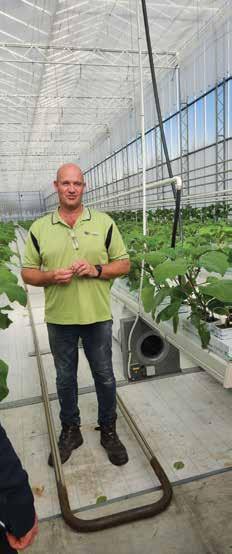

Teachers really value an opportunity to meet growers and understand more about vegetable growing from field to plate. The experience deepens understanding and provides valuable information to share with their students, so we greatly appreciate all the growers who open their gates and willingly answer so many questions!
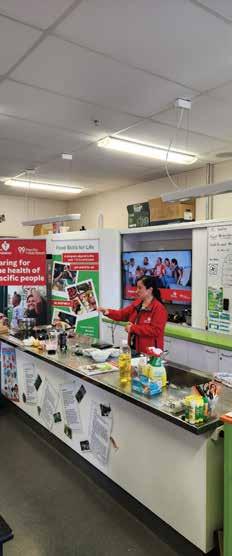 Kees Van Der Eijk
Kees Van Der Eijk
New Zealand-first Ironmax Pro® – the tough ‘soft’ option
The first slug bait in New Zealand to be BioGro certified, Ironmax Pro from UPL Ltd, is the pest control green light growers have been waiting for. Combining efficacy against slugs and snails with an enviable environmental profile, the innovative product is a godsend for a market seeking better, safer ways to save crops from destruction.
Manufactured by French company De Sangosse, a global leader in slug and snail bait technology, Ironmax Pro is the latest generation of a line of successful products that includes Metarex® Inov and Metarex Micro. Trusted by generations of New Zealand vegetable growers, Metarex Inov was itself a breakthrough product at the time of its launch.
“They ultimately selected down to two extraordinarily attractive and palatable molecules. These facilitate rapid detection by slugs and snails and enhance Ironmax Pro’s taste and therefore how quickly Ironmax Pro works compared to other baits.” Research shows slugs actively prefer feeding on Ironmax Pro to feeding on seedlings.
Mike Goodwin, UPL NZ Ltd Central South Island regional manager, says it’s the BioGro New Zealand organic certification that makes Ironmax Pro a real game changer. “There’s increasing demand from the industry for products that are safer for the environment without compromising on efficacy.”
Mike says that if unchecked, grey field slugs (Deroceras reticulatum) have the potential to wipe out an entire crop. The voracious feeders cause damage across a broad range of crops but are a particular problem in lettuces and vegetable brassicas.
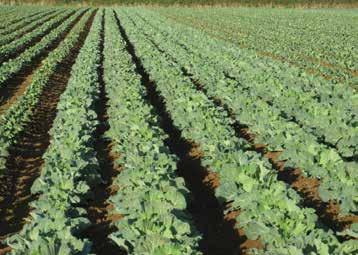
New Zealand’s temperate climate is especially slug and snail-friendly. The pests are active year-round and, with the ability to produce 300 eggs in their 13-month lifespan, Mike says population explosions are a constant threat.
One of the things which separates Ironmax Pro from conventional slug baits is its Colzactive® technology. Colzactive is made up of specially selected rape seed oil extracts. Mike says the De Sangosse Research & Development team evaluated 20 plant species and identified 50 potential molecules based on their appeal to slugs.
Ironmax Pro contains the optimised active ingredient 24.2 g/kg ferric phosphate anhydrous, referred to as IPMax. Iron (ferric) phosphate is a natural component of soil. In Ironmax Pro, it works as a stomach poison on slugs and snails and is fatal once ingested. Feeding stops almost immediately.
Ironmax Pro is manufactured with the finest durum wheat using a unique wet process which makes it rain-fast. Compatible with Integrated Pest Management, Ironmax Pro does not impact beneficials, including earthworms and the slug predator carabid beetle.
Ironmax Pro has a recommended application rate range of 5 to 7 kg/ha. With 60,000 baits per kilogram, Mike says the product has excellent ballistic properties. “The uniform pellet size and innovative Ironmax Pro manufacturing process mean the bait can be spread at widths of up to 24 metres.”
Talk to your local technical representative for more details on Ironmax Pro. Our website www.upl-ltd.com/ nz/product-details/ironmax-pro
New Zealand’s temperate climate is especially slug and snail-friendly. The pests are active year-round
While much precise planning goes into harvesting that perfect potato, maintaining that field freshness can only be achieved through carefully controlled storage temperature and conditions post-harvest.

Spray foam insulation manufacturer and installer NZFoam provided a South Canterbury farm with a controlled environment for its 3500 tonne annual yield of five varieties of the great Kiwi spud. The crop from Crichel Down Potatoes is produced for processors such as Talley’s for their frozen fries.
Low temperatures make potatoes too high in sugars, not great for frying,” says Simon Binnie, operations manager for Guy and Jane Slater’s Wakanui farm.
“Too hot, and the moisture evaporates causing a wrinkly potato. You need to store them at a constant temperature for the perfect yield.”
Three years ago, Simon enlisted NZFoam to insulate the farm’s pole shed. After great success, two concrete tilt slab room extensions with a drive-on drying floor were built in January last year. He then called up the team at NZFoam who were on the job the next month.
“They completed it very quickly and were very pleasurable and reliable to work with.”
Blending in well with the rural environment, the outside walls and roof were sprayed with 90mm of foam and 50mm on the inside.
“When storing potatoes you don’t want any condensation, just a consistently dry environment. The foam really improves that.
Pump warm air in from outside first to dry the potatoes; about 12 degrees warms them up a bit and stops bruising. Then we hold the temperature at a constant 9–10 degrees for five months of the year, until late September. It could be – 1 to 15 degrees outside, but the temperature won’t change inside.
I heard really good reports about NZFoam being the best foam insulation, from Nigel Reith who owns The Rakaia Hub produce storage sheds, and also from Talley’s where I worked for 15 years.
We also foamed the shed’s engine room – our fan room, where the three huge fans make a hell of noise – and the foam stopped any sound from annoying the neighbours!

Once we move out the potatoes, the inside walls are so easy to waterblast down, then we move in 400 tonnes of grass seed, wheat and barley. So the sheds are in use at least 10 months of the year. Fertilisers and the tractor are stored there too.”
He says they used to outsource all the potato storage, so now having onsite storage sheds is far more economical.
“The spray foam certainly pays for itself.”
In times like these, we’re all thinking about ways to make our businesses more secure and looking for ways to cut costs. Creating a cool store on your property might be simpler than you thought. NZ Foam has managed new cool store builds and also created cool stores from existing buildings for growers all around New Zealand. And it works for fruit storage, too!
To learn more visit www.convertmyshed.co.nz
For a guide to maintaining your system, we spoke to Mike Astrop, National Sales Manager at Aquaspec, supplier of irrigation systems to Fruitfed Supplies. Mike says to support crops reaching their optimal yield, plants need to be delivered accurate quantities of water directly to the roots. With a grower often required to adhere to a strict volume of water due to daily usage limits, installing and maintaining an efficient irrigation system will help eliminate any wastage.
Here’s Mike’s simple checklist designed to assist you with completing regular maintenance of your irrigation system.
• Often overlooked, Mike says at the beginning of every season update the system’s controller to ensure it is programmed to deliver water at the right time to each of the zones on the property.
• Walk the crops to monitor if all the zones on the property are being delivered water as programmed through the controller.
• Take a close look at the system’s pipes and fittings. Are there any leaks and cracks affecting the flow rate? With soil build-up and vermin often the cause of damage over the winter months, check to see if any components need replacing.
• Mike suggests flushing pipes to remove any blockages which can be caused by soil sediment, slime or other residues. Open the ends of the lines and flush the system until the water runs clear. Reseal the ends when you’ve finished.
• Check the system’s drippers, sprays or sprinklers are delivering water to the correct area, at the optimal rate. If you have any faulty emitters, either replace them or give them a clean.
• Clean the filters.
• Monitor the water tanks, checking they are filled with good quality water. Mike says sometimes rodents or large amounts of organic matter, such as leaves or feathers can be present, so the tank may need cleaning or the screens checked so they are clear.
Steve Wood, Fruitfed Supplies Technical Horticultural Representative, based in Te Puke shares how he helps his customers with regular maintenance on their irrigation systems. “We service the inline injection units for fertigation as well as assisting with the replacement of componentry for the irrigation system. If replacement sprinklers are required, I simply take one to identify the correct part and place the order with the supplier. We aim to make the maintenance process as easy as we can for our customers,” says Steve.
For assistance with maintaining your irrigation system, or

discuss upgrading or installing a new system, speak to your local Fruitfed Supplies Technical Horticultural Representative or visit your local Fruitfed Supplies store.
Visit fruitfedsupplies.co.nz to find out more about Fruitfed Supplies’ range of products and services, or to find a store near you.
Fruitfed Supplies is a trading division of PGG Wrightson Ltd (PGW). PGW and the writer do not warrant the information’s accuracy, quality, outcome or fitness for any purpose.
Mike says to support crops reaching their optimal yield, plants need to be delivered accurate quantities of water directly to the roots
to
Completing regular maintenance of your irrigation system will help ensure it remains at its most efficient when delivering water and fertigation to crops.



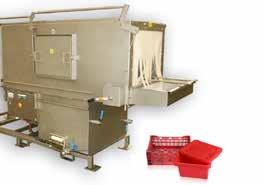
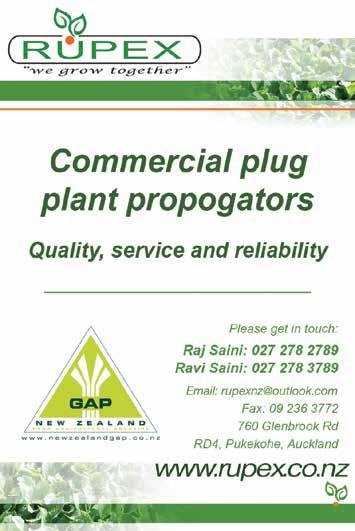


Optimal balance between oxygen and moisture level in substrate results in healthy root development.

The module and groscale minimizes time consuming guesswork and results in less use of precious resources like water and fertilizers.
The module and groscale simplifies irrigation management for many varieties and breeds, so it’s suitable for single or multiple crop sites.
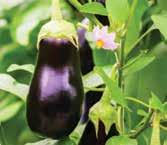


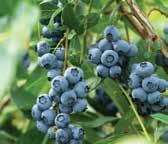



The module and groscale requires greenhouse sensors to execute the optimal irrigation. They can connect wirelessly to the Priva system.
